Random content creation is the top reason you won’t see ROI from your content marketing.
One week, you write blog posts. The next week, you film some YouTube videos. Then, you stop publishing for three months.
With a strong content strategy, you’ll make consistent content based on real customer preferences, pain points, and historical data.
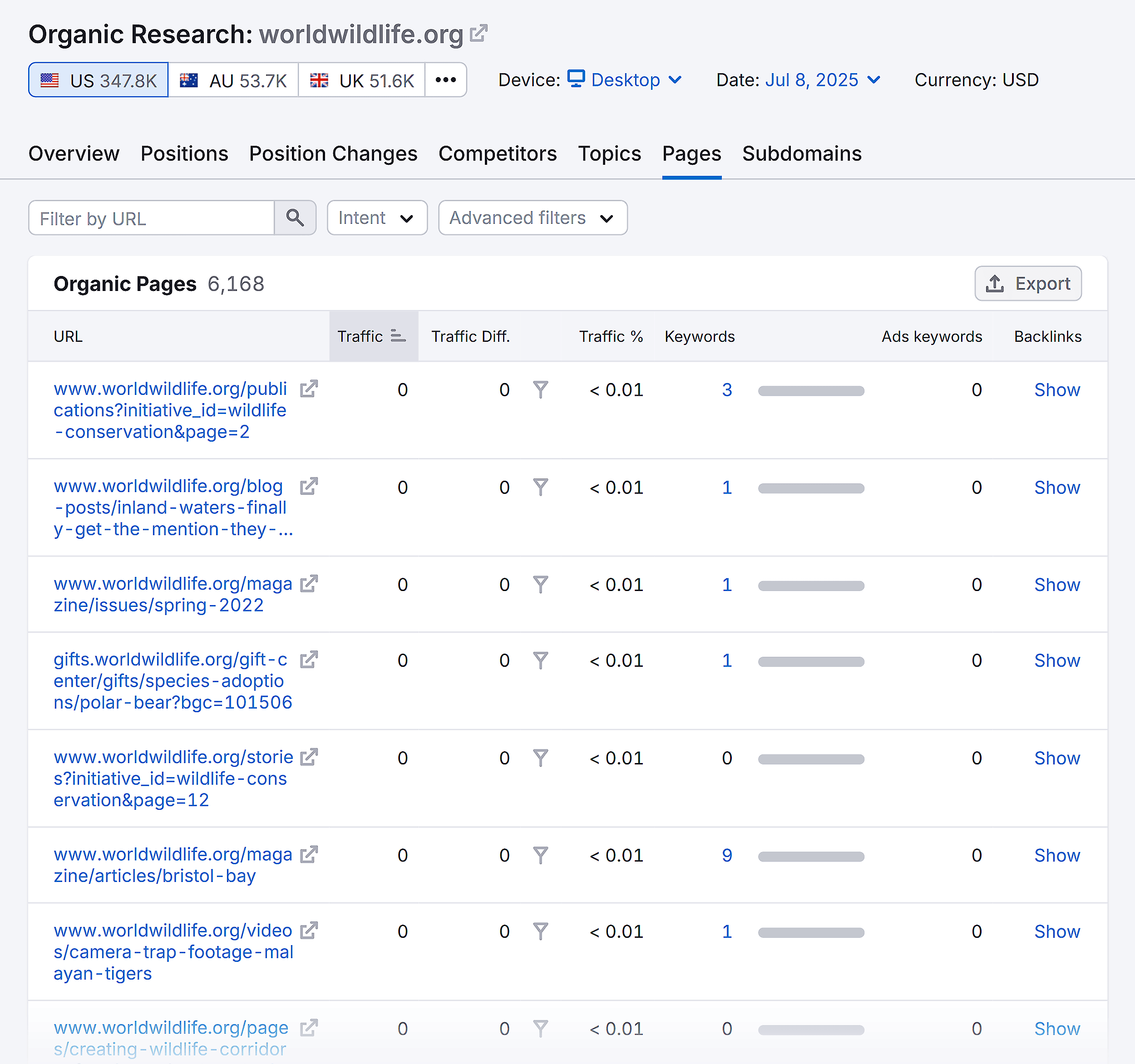
Creating a content strategy has many benefits, including:
- Focuses your efforts on content your audience actually wants
- Saves you time by eliminating guesswork and random content creation
- Drives consistent traffic through strategic topic selection
- Builds authority in your industry with purposeful, high-quality content
- Increases conversions by aligning content with your audience’s needs
Let’s dive in.
What is a Content Strategy?
Before we get into the steps, let’s align on what “content strategy” actually means.
Because, let’s be honest, it’s not totally clear.
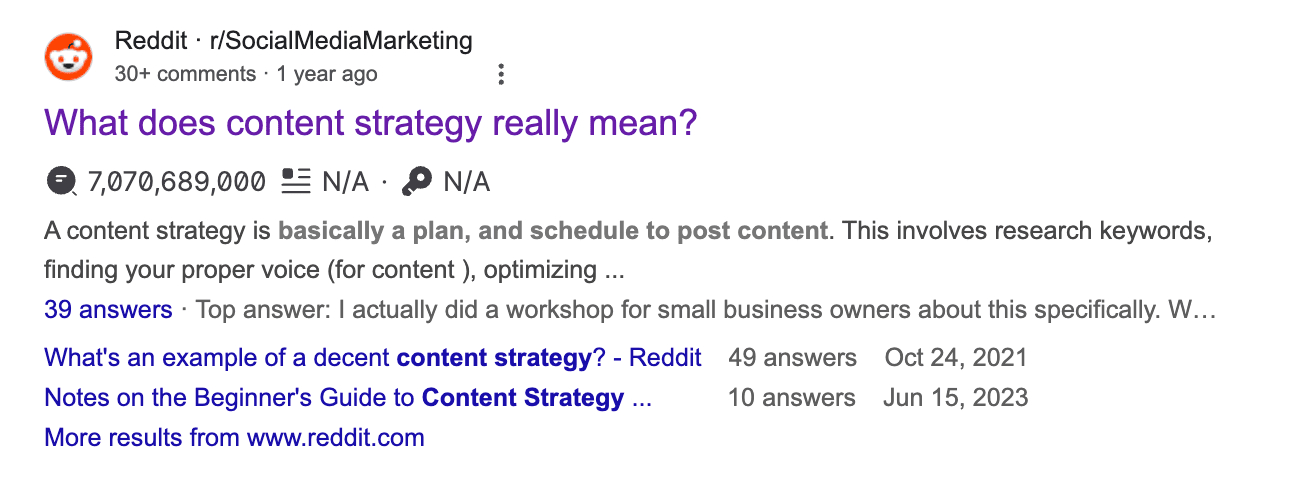
Content strategy is the plan for creating and distributing content that serves your audience’s needs and supports your business goals.
It’s not just brainstorming cool ideas or hitting “publish” on an Instagram post.
It’s providing high-quality content that:
- Your audience actually wants/needs
- Changes the way they interact with your brand
Done well, your content should:
- Build trust in your brand
- Encourage engagement and connection
- Move people closer to a purchase or other key action
In other words, strategy is the thinking that makes your content matter.
Now let’s walk through how to actually do that, step by step.
Step 1: Align Your Content Strategy with Customer Awareness Levels
Every content decision you make should map back to the customer awareness levels:
- Unaware
- Problem Aware
- Solution Aware
- Product Aware
- Most Aware
This includes the topics you cover, formats you use, and where you publish.
Why?
Because people at different awareness stages need completely different content.
Someone who has never heard of your solution needs education, while someone comparing options needs proof that your product is best.
But forget what you’ve been taught in the past.
Start with people ready to buy (most aware) and work backward.
This sets you up for faster wins, better conversion rates, and less competition.

Here’s what this looks like in practice.
Most Aware
People in the “Most Aware” stage are VERY close to buying your product or service.
They’ve likely already inquired about your offering, requested pricing info, and used your free trial.
Now, they just need that final push.
Design your Most Aware content to remove hesitation and make the next step feel obvious.
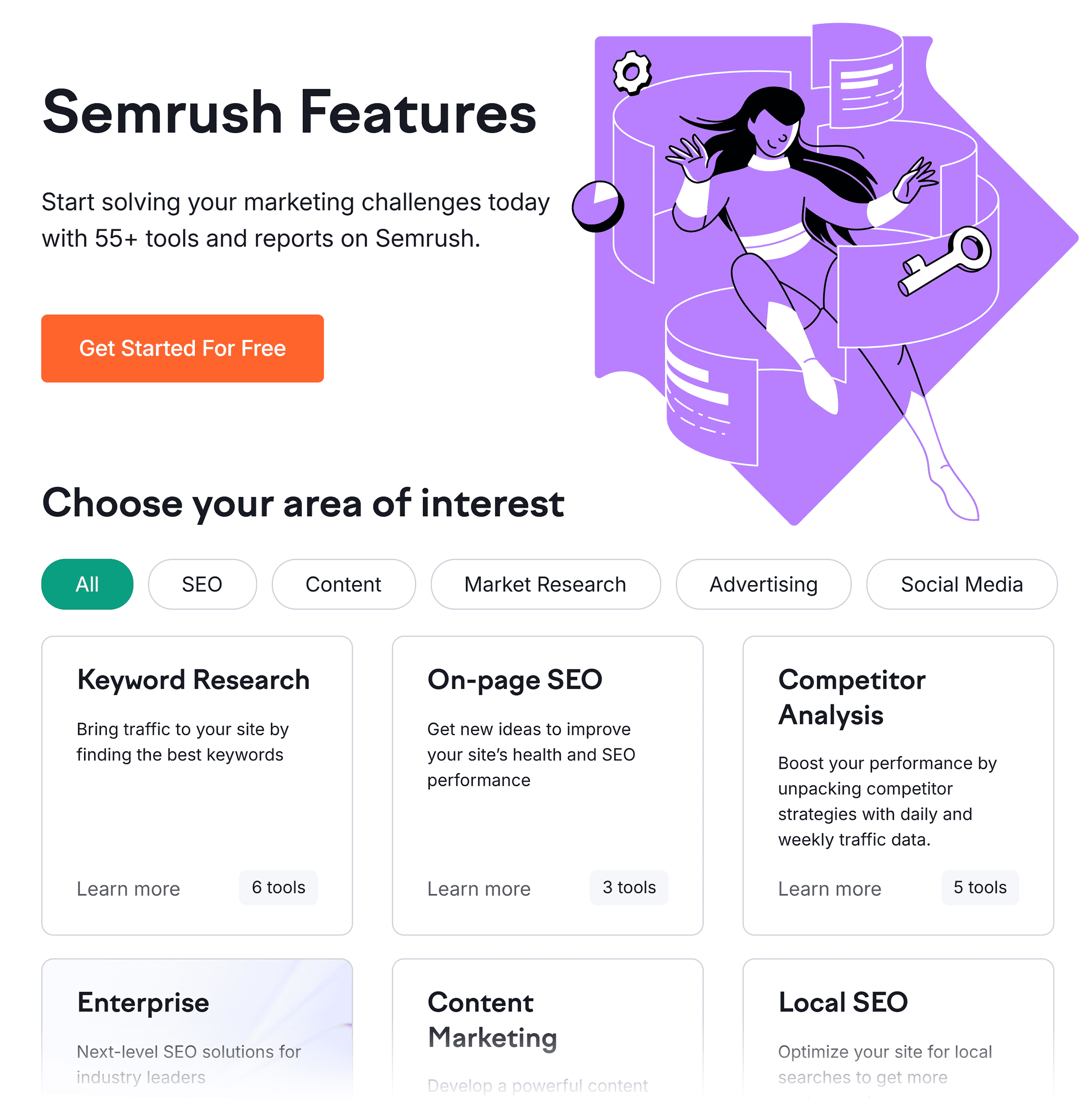
Content that works best for this stage includes:
- Customer success videos
- Live demos and Q&As
- Pricing guides and ROI calculators
- Email campaigns with time-sensitive offers
For example, Semrush has a dedicated “Success Stories” page.
Each story highlights how companies use the platform to improve their online visibility, rankings, and content.
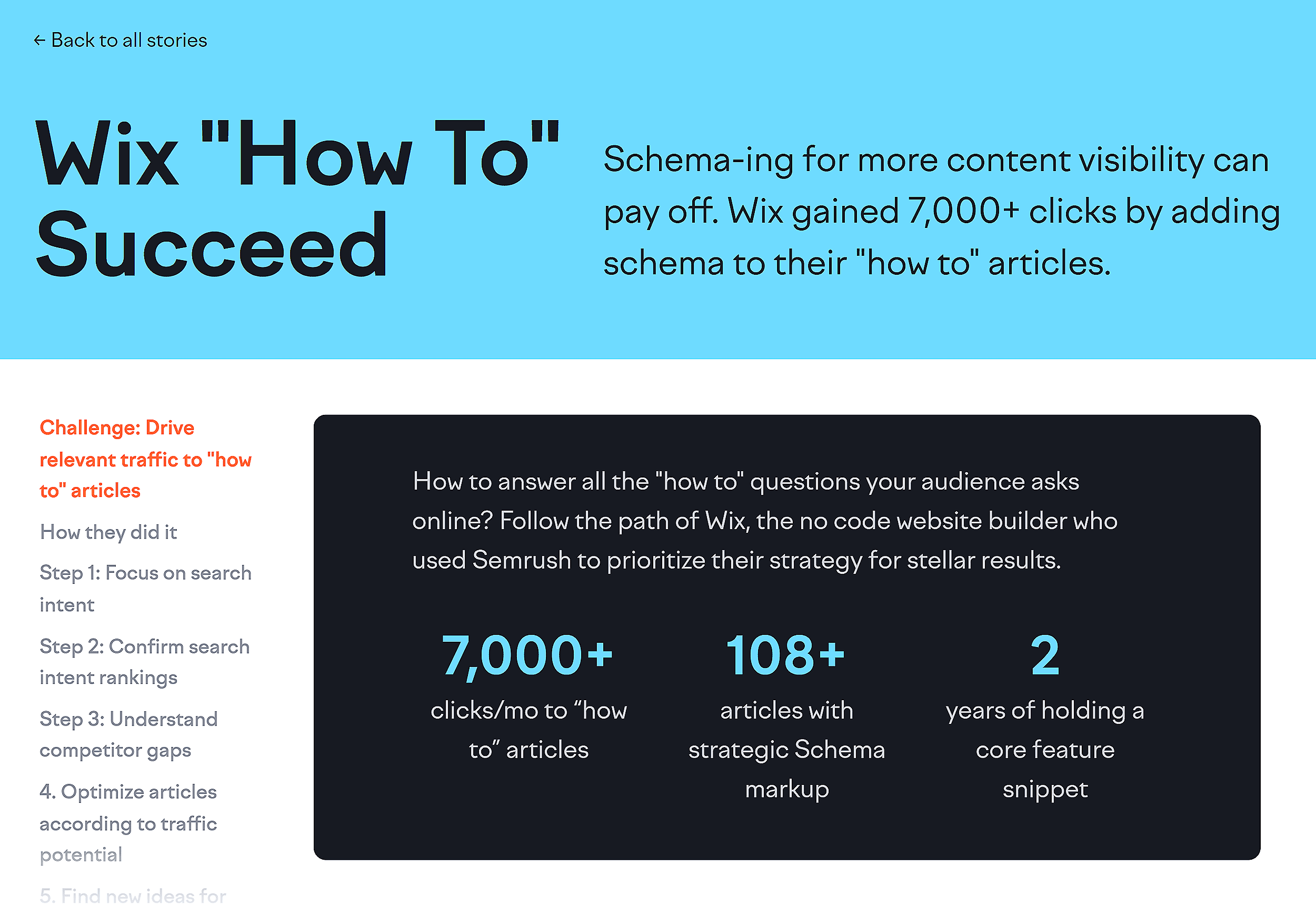
Even better? They all end with a free trial offer.
That’s textbook Most Aware content: high trust, low friction, and a clear next step.

Product Aware
People in the Product Aware stage know they need a solution and are shopping around.
They’re comparing features, reading reviews, and weighing pros and cons.
They may have even started free trials with your competitors.
Your job? Make your solution the obvious choice.

Product Aware content includes:
- Product walkthrough videos
- Comparison posts and tools
- Influencer or customer reviews
- Webinars with customer case studies
Pro tip: Make comparison content a priority in your content strategy. This is where prospects make their final decisions.
Solution Aware
At this stage, prospects know they have a problem — and that solutions exist.
But they’re still figuring out what kind of solution they need.
They’re asking questions like “What is SEO software?” or “How do others solve my same problem?”

Your job is to guide them through the decision.
This is where you earn trust and shape buying criteria.
Solution Aware content includes:
- Case studies
- How-to guides and educational content
- Podcast episodes or blog interviews
- Interactive tools or quizzes to assess needs or priorities
- Video testimonials from customers

Problem Aware
In this stage, prospects know they have a problem. They just don’t know what to do about it yet.
They’re asking questions like:
- What’s causing this issue?
- How serious is it?
- Am I the only one dealing with this?
- Is there a fix?
At this point, they’re digging into Google and large language model (LLM) results, Reddit threads, YouTube videos, and niche forums.
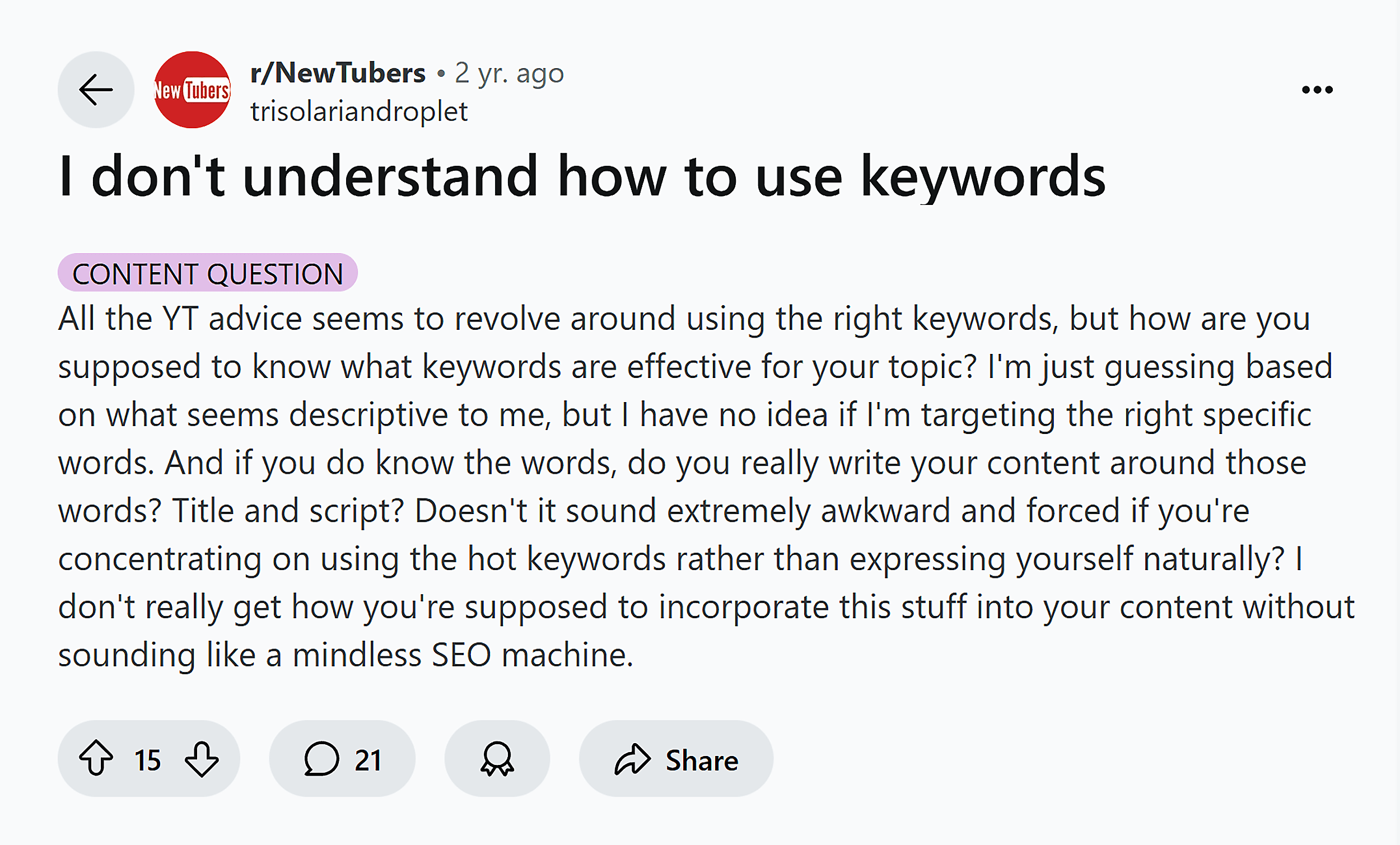
They’re looking for answers and insights — not product hard sells. That’s where your content comes in.
Your job here is to validate their problem and help them understand it more clearly.
Content that works best in this stage:
- Blog posts that explore the root causes of common problems
- Social content that highlights signs, symptoms, or overlooked issues
- YouTube videos breaking down key pain points
- Forum posts or comments that share useful perspectives
Use tools like Google’s Autocomplete, People Also Ask, and Semrush’s Keyword Magic Tool to find real questions your audience is asking.
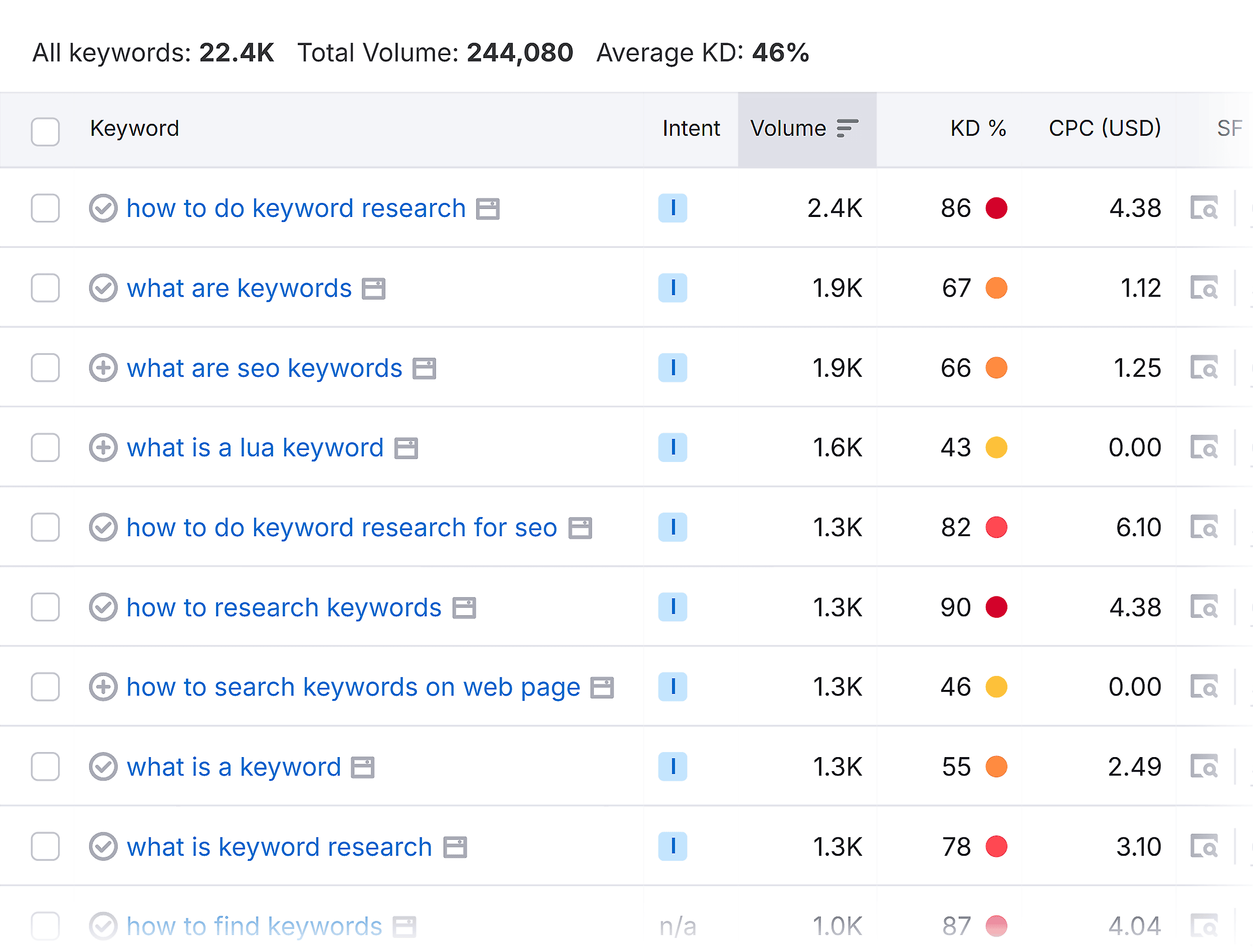
Then, plan content that empathizes with your audience’s problem and hints at the types of solutions that exist.
Build trust in this stage, and you’ll stay top of mind when they’re ready to buy.
Unaware
Unaware prospects don’t know they have a problem — yet.
They’re not searching for solutions. They’re not asking questions. They’re not even looking.
That makes this audience the biggest and the coldest.
Your goal here isn’t to sell. It’s to spark that light bulb moment where they realize there’s a problem worth solving.
And you’ll want to do it in a way that feels helpful, not pushy.
The best content for this stage is light, relatable, and built for discovery.
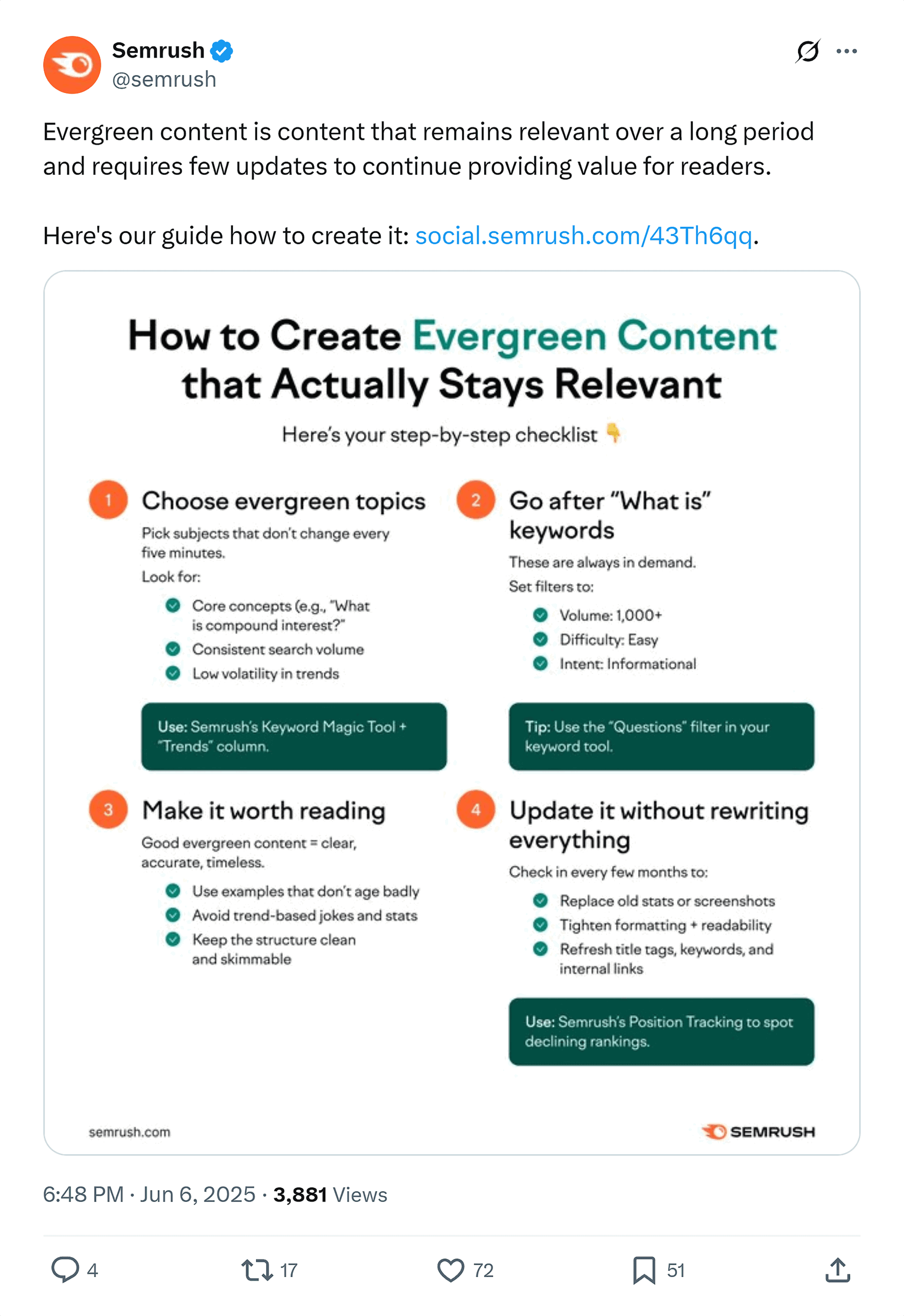
Think:
- Short videos or animations on social platforms
- Blog posts tied to lifestyle or work challenges
- Paid ads that highlight common frustrations in a simple way
For example, Semrush uses TikTok to create short, relatable videos aimed at digital marketers.

One important note: Don’t expect immediate returns from Unaware content.
This is all about brand awareness and building trust.
But when these prospects eventually realize they have a problem, guess whose brand they’ll remember?
That’s right — yours!
Step 2: Find and Prioritize High-Impact Content Ideas
Strategic topic selection is more important than ever.
Content demands have skyrocketed. Channels are crowded. And your audience is drowning in options.
AI and LLMs have also fundamentally changed how people discover content.
Using a process called query fan-out, they break one search into multiple related questions and topics to anticipate the user’s needs.
That’s why it’s important to think in content clusters, not just individual topics.
Here’s how to find (and prioritize) topics in a smart, scalable way.
Start with Customer and Client Research
Before you open a keyword tool, review your inquiries, support tickets, and sales calls to see what questions come up again and again.
This reveals high-intent problems your audience is actively trying to solve, which makes it perfect for your content strategy.
If you have existing customers, send short surveys to them by email.
Ask questions like:
- What’s your biggest challenge with [topic]?
- What would you search for when looking for [solution type]?
You can also run polls on LinkedIn, Instagram, X, and more.
And consider offering a small incentive to encourage responses.

As you get responses, group them by themes to plan for content clusters.
This lets you capture the full search journey around each topic. And will help increase your visibility in traditional and AI search engines.
Audit Your Existing Content for Hidden Winners
Look at your existing content to assess what’s already working. And find content gaps worth filling.
Here’s how:
First, log in to Google Analytics to see which topics and formats drive the most valuable traffic to your site.
Then, go to “Reports” → “Engagement” → “Landing Pages”:

This report shows you which pages users land on first when they visit your site.
So, you know which topics and pages attract them the most.

Look at performance metrics like sessions, average engagement time, and key events to identify top performers.
Next, identify what those pages have in common in terms of:
- Format: Are they how-to guides, listicles, case studies, or something else?
- Topics: What themes or subject areas dominate?
- Length: Are they comprehensive deep-dives or quick reads?
- Content angle: Do they focus on beginner tips, advanced strategies, or industry news?
Once you spot the patterns, you can plan to create more content that fits these winning formulas.
For example:
A while back, we noticed that definitive guides brought in a ton of traffic.
So, we decided to publish more definitive guides as content pillars.

And those new guides helped increase my blog’s traffic by 87.91% compared to the year before:
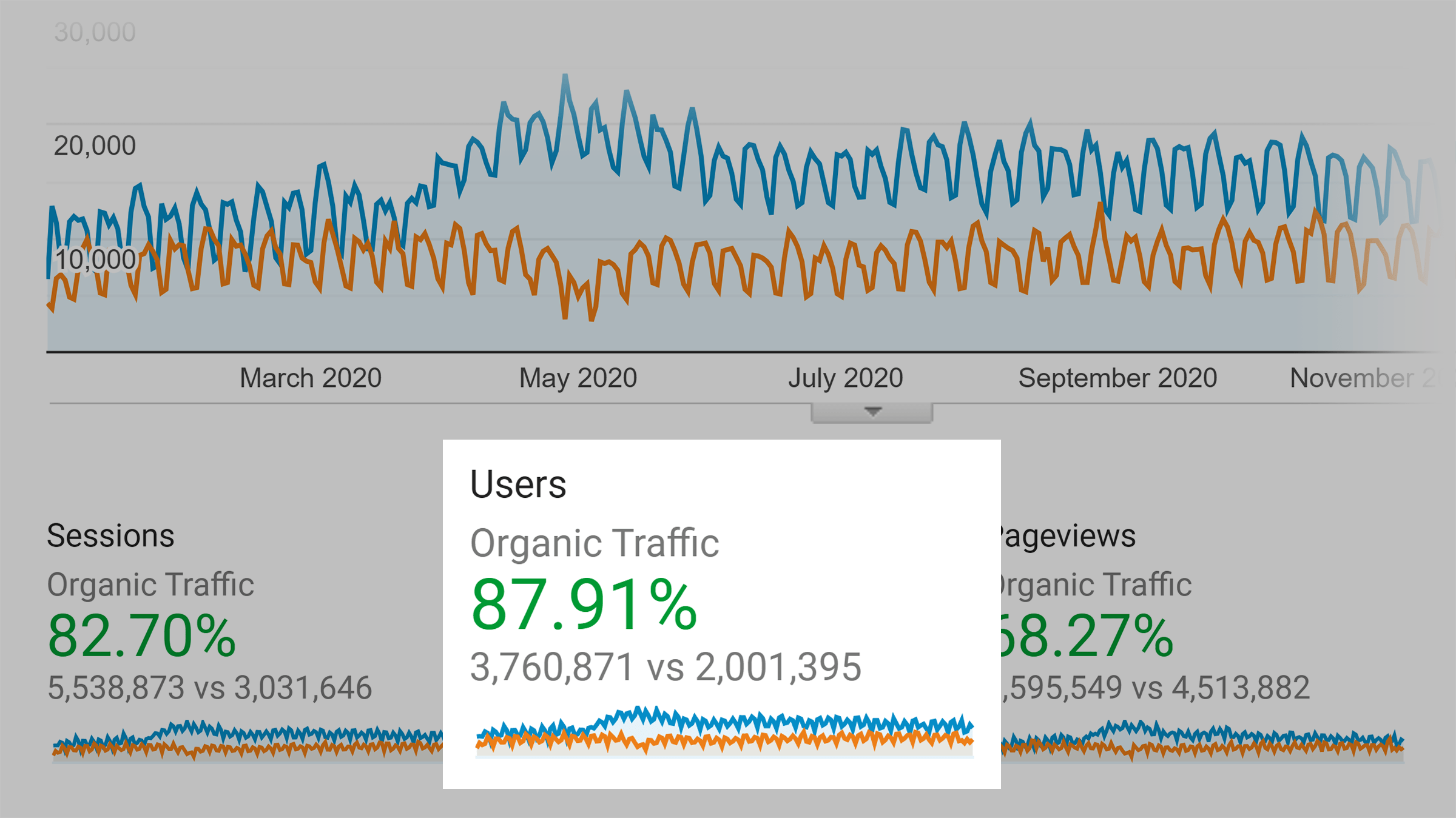
The biggest takeaway? Your existing data already shows you what your audience wants.
You just need to give them more of it.
Run a Cross-Platform Competitive Analysis
Want a goldmine of validated topics and format inspiration?
Spy on your competitors, platform by platform.
This can be anything from social media accounts and blogs to podcasts and videos.
For example, if your competitors are on YouTube, filter their content by “Popular” to see which topics get the most views and engagement.

Over on LinkedIn, you can scan your competitors’ profiles for posts with high comment or repost counts.
Find their company page, click “Posts,” and start scrolling.

Competitor blogs are also a great source of topic inspiration.
For example, a while back, we looked at what content performed best on the Moz blog:
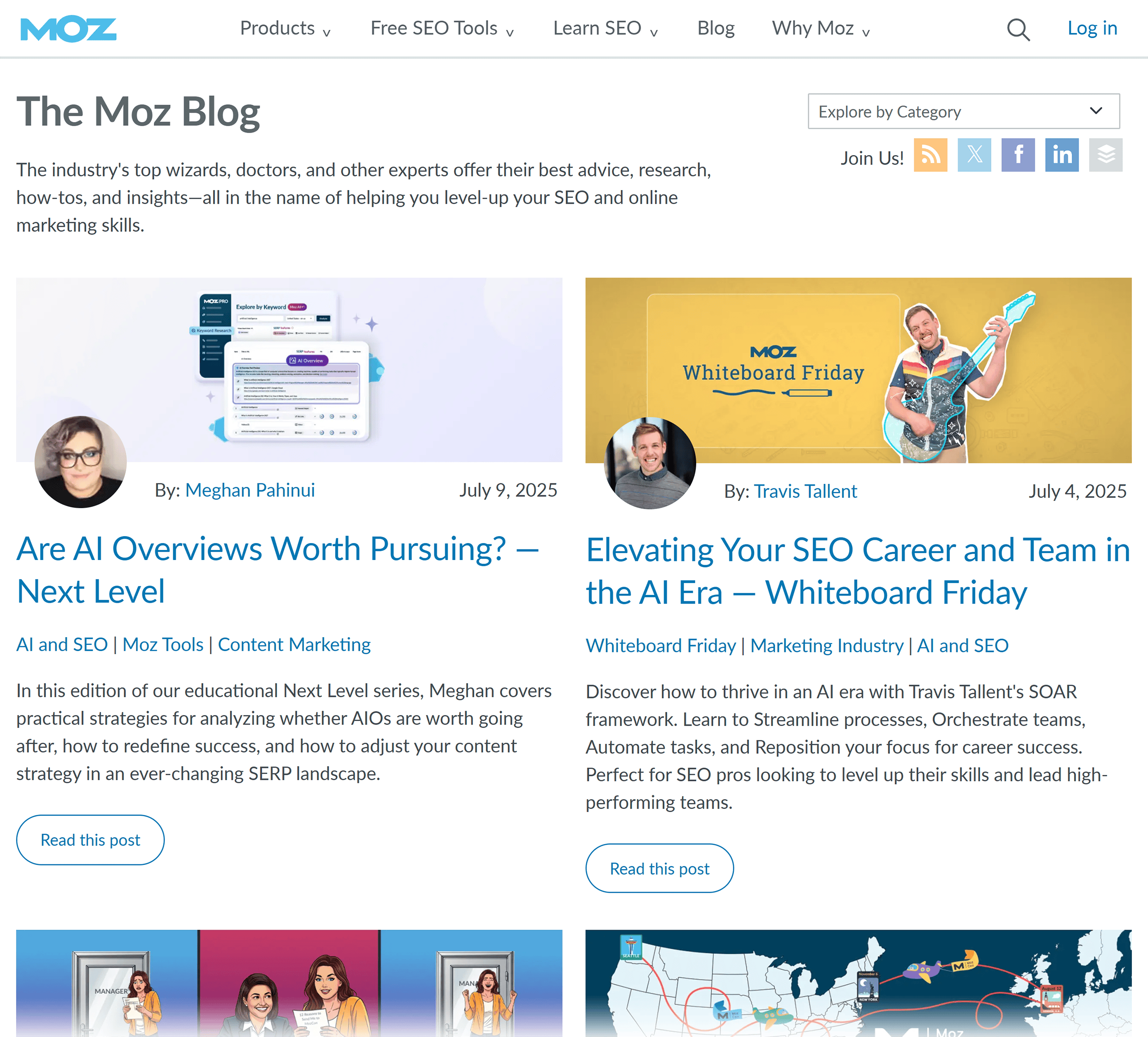
And we noticed that content about “site audits” tended to do REALLY well:
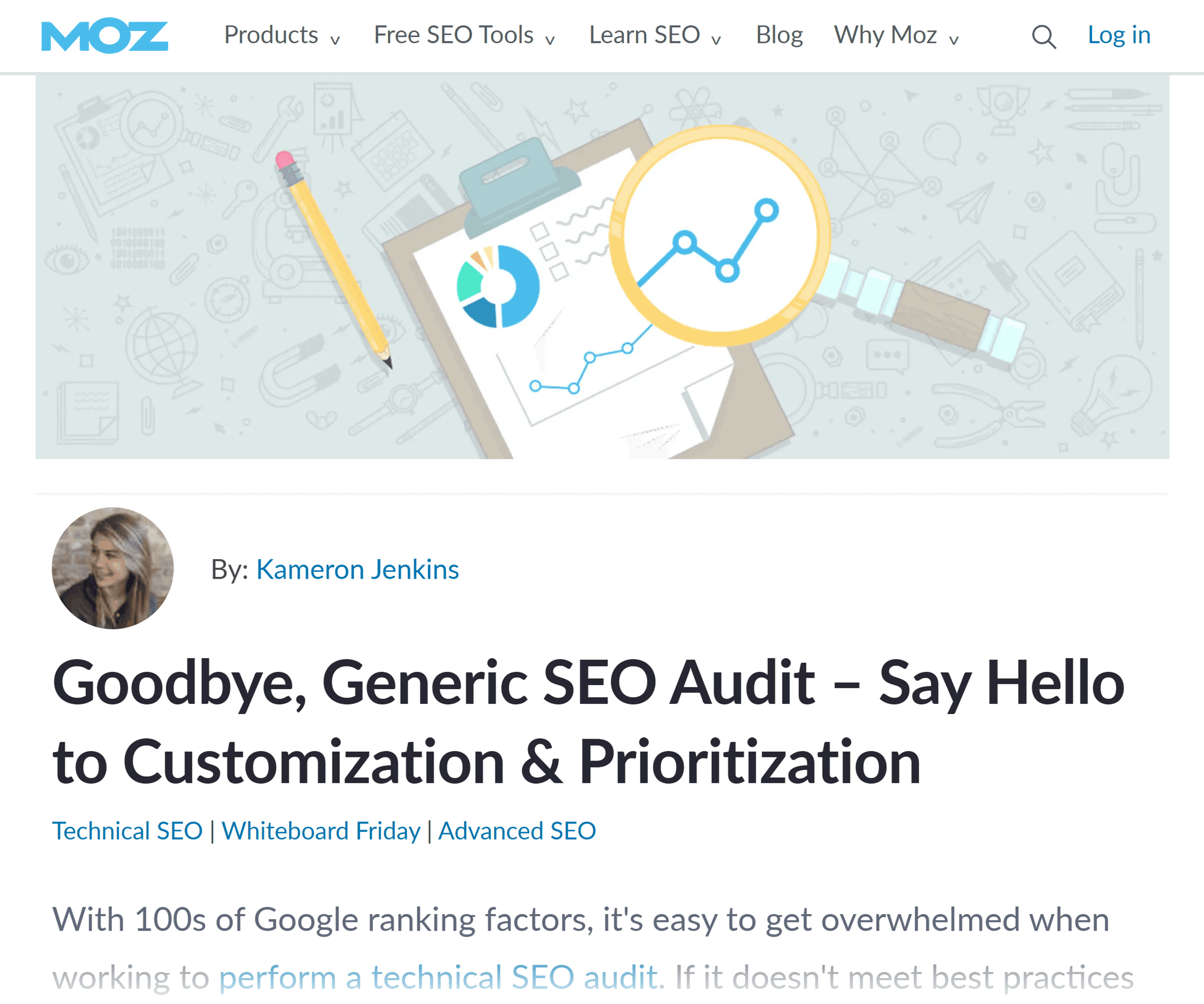
So, we created a blog post called: “The 18-Step SEO Audit Checklist.”
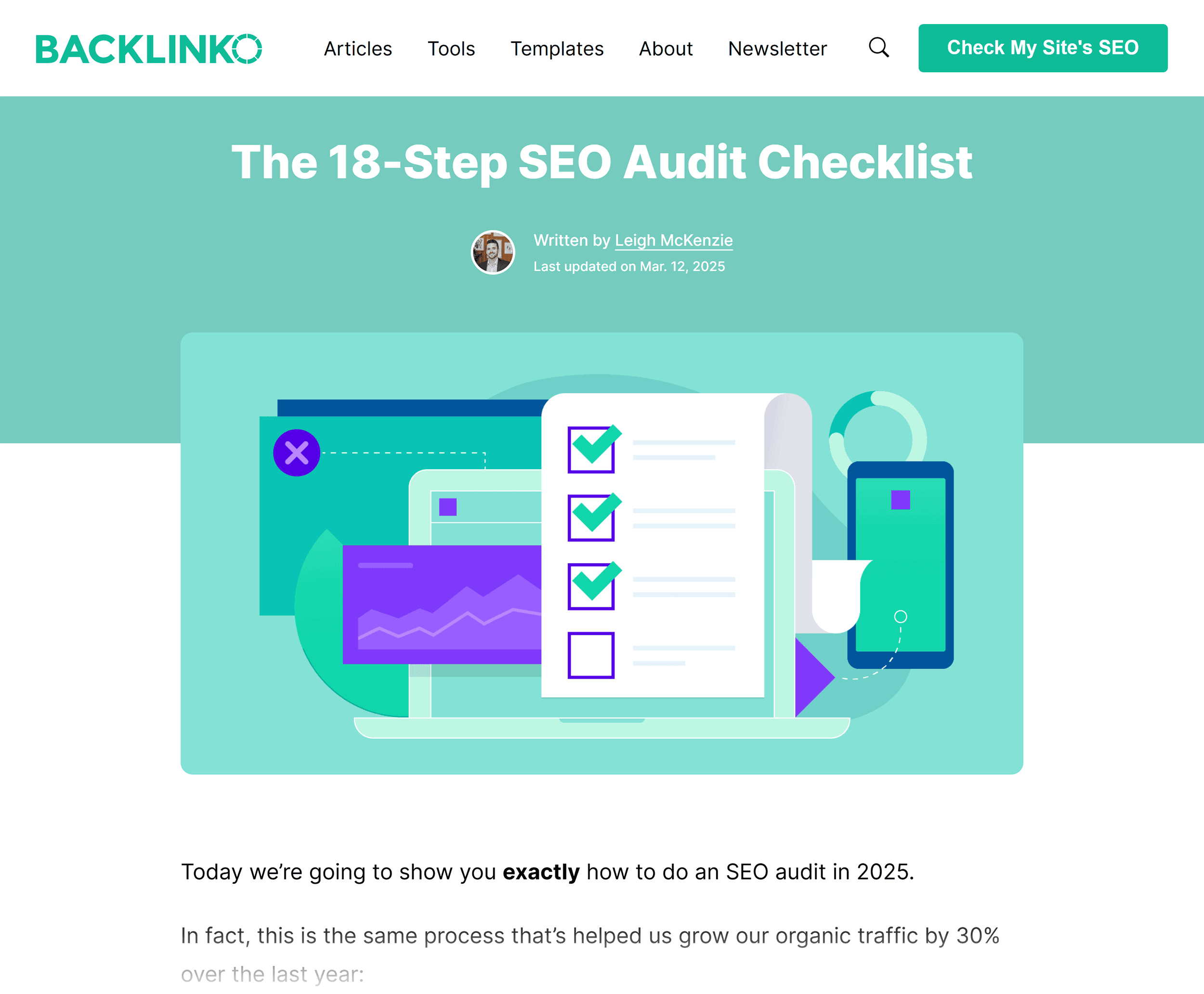
Because this post was based on a proven topic, it was a huge hit on day 1.
And quickly cracked the first page for my target keyword:

Podcasts are another amazing (and somewhat untapped) source of topic inspiration.
Check out your competitors’ episode lists on Apple Podcasts or Spotify.
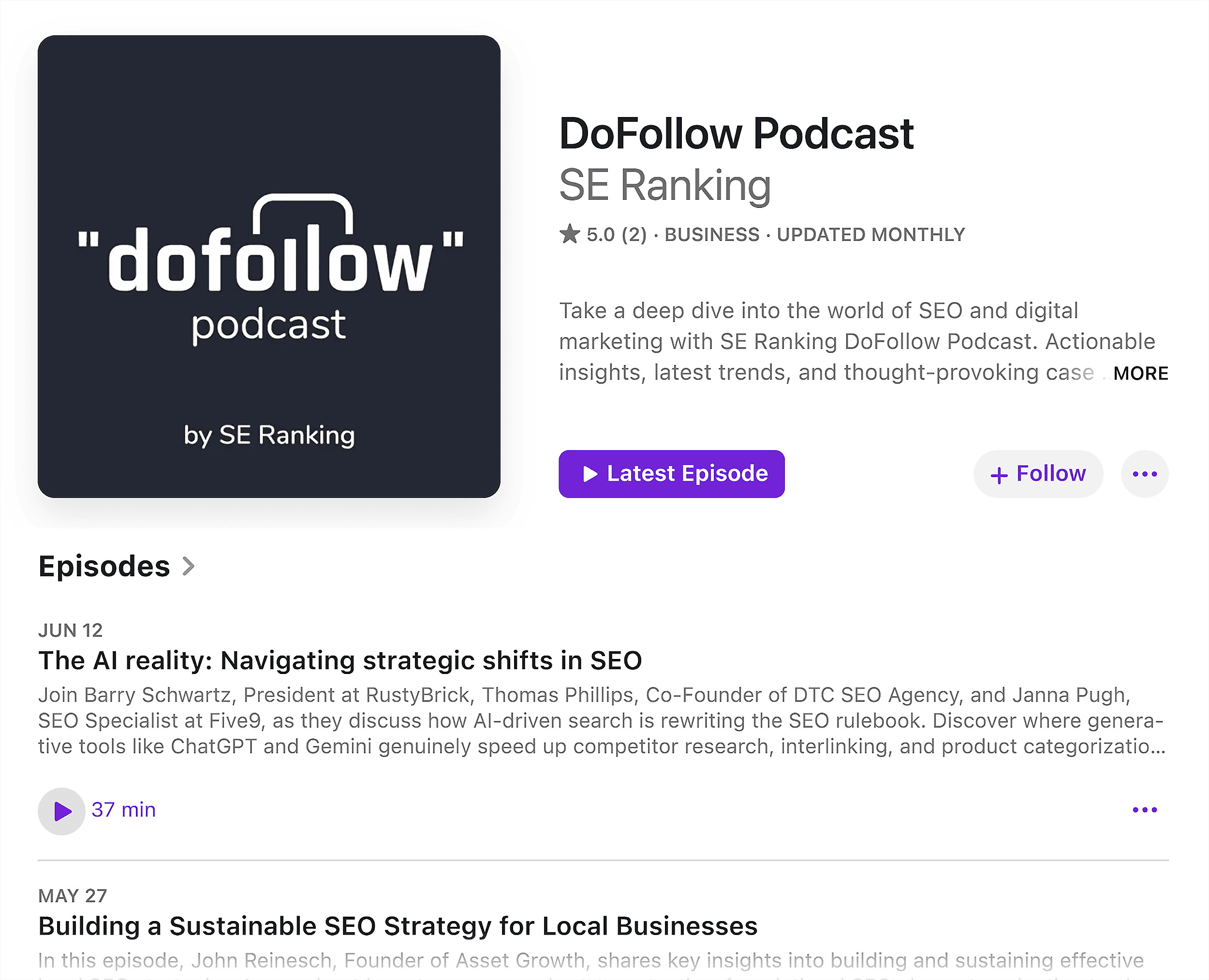
This can reveal some killer topics you’d be hard-pressed to find any other way.

Once you’ve done a manual review, use competitive research tools for deeper analysis.
For this task, I’ll use Semrush.
Here’s how you can follow along:
First, sign up for a free 14-day Semrush trial.
Then, start with the Organic Research tool.
Enter one of your top competitors’ domains and click “Search.”
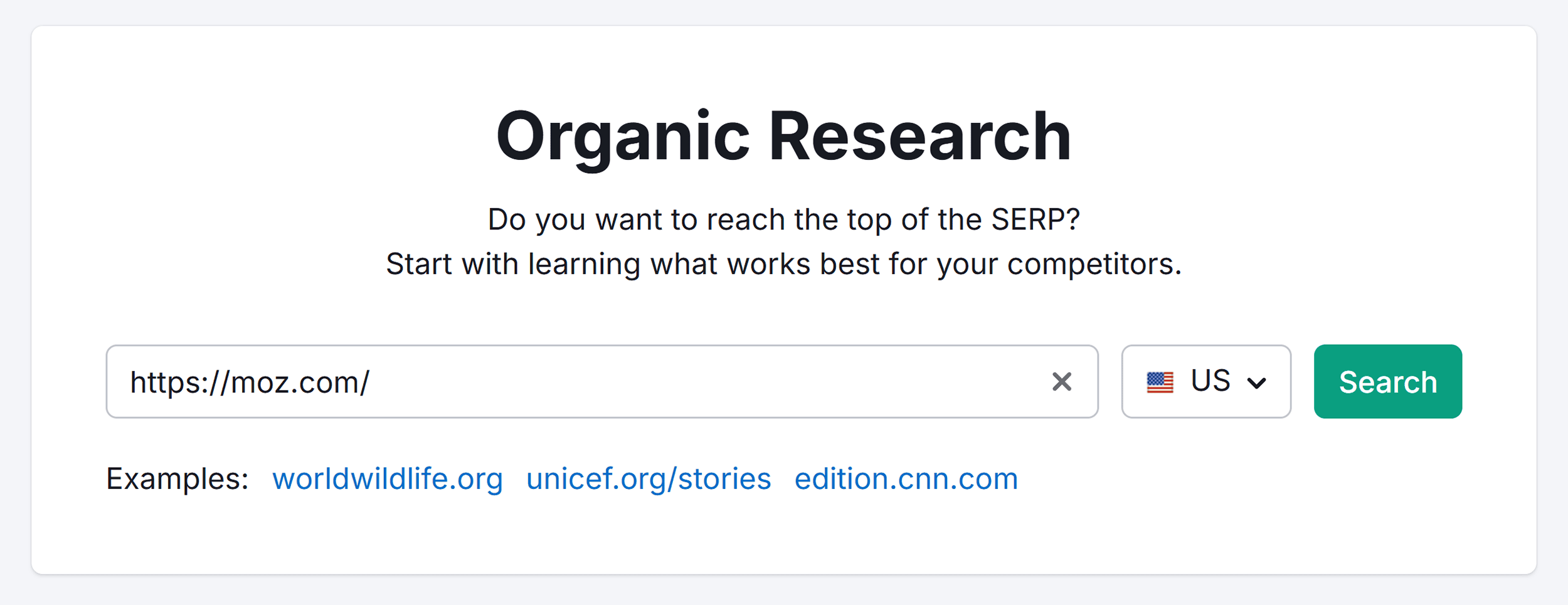
You’ll see an overview of their top-ranking keywords.
And which pages attract the most traffic.
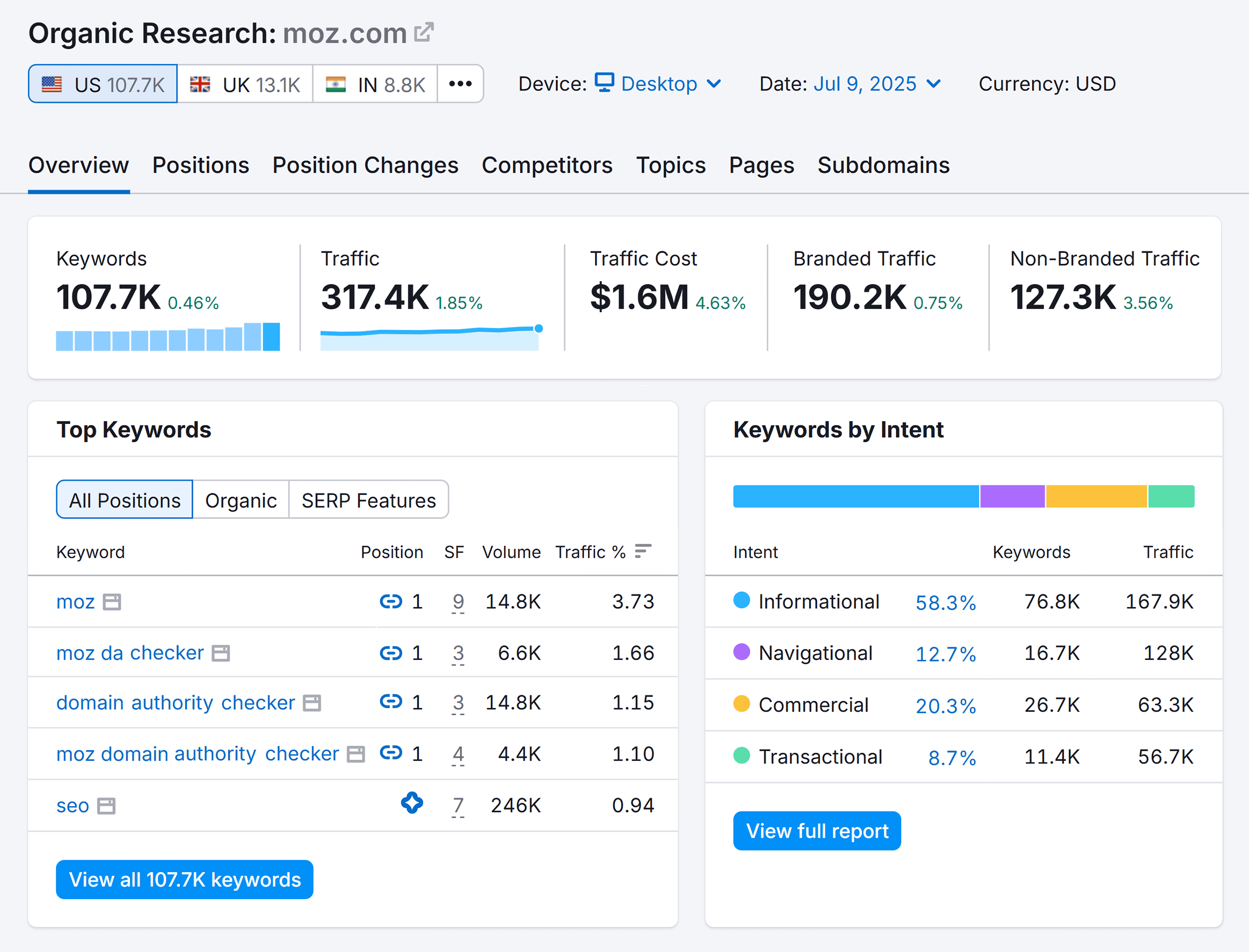
Switch to the “Position Changes” tab on the menu for a deeper look at the keywords your competitor has won and lost.
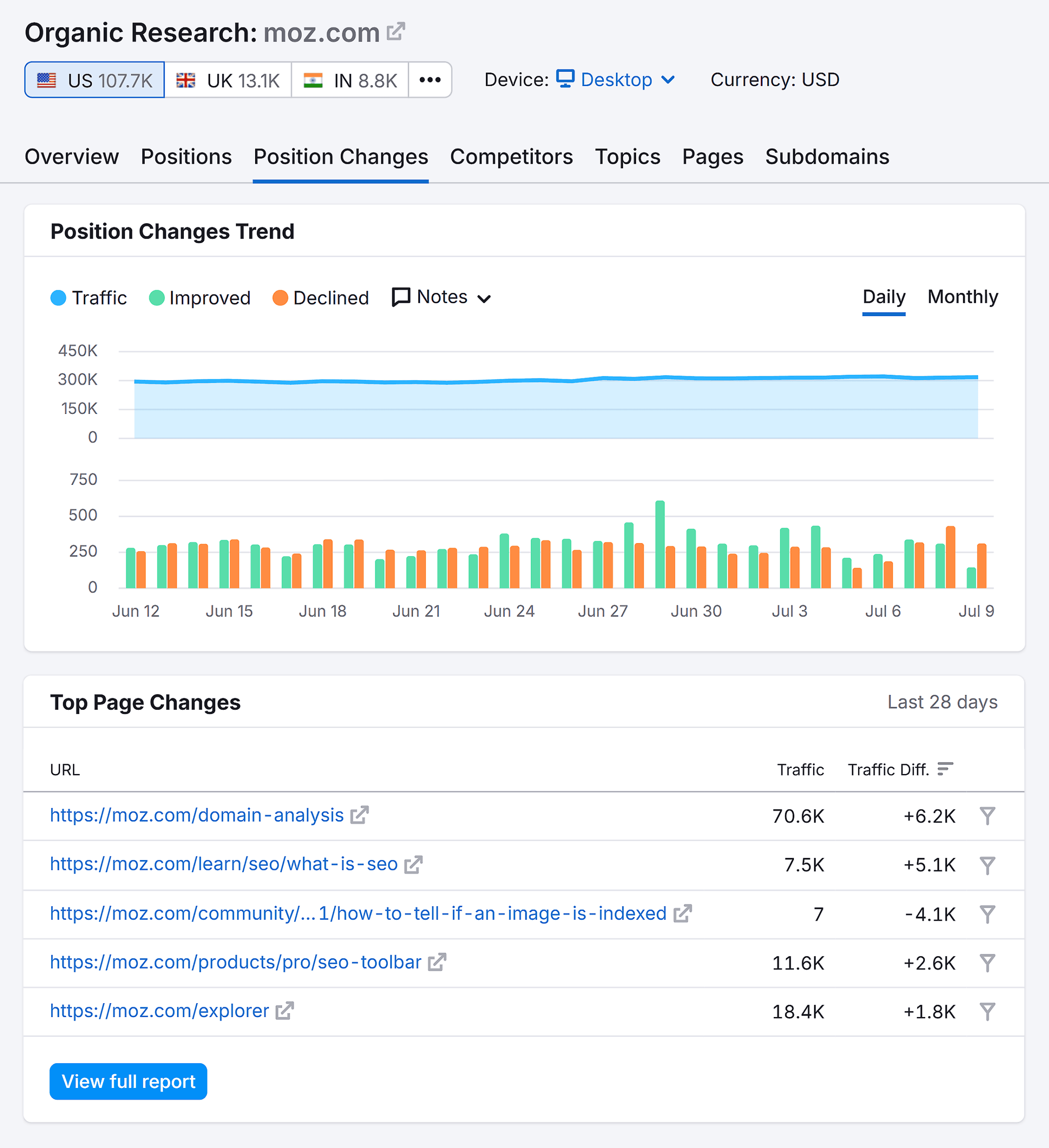
One strategy?
Start by reviewing your rivals’ keyword losses and add any relevant topics to your strategy.
Why?
So, you can swoop in with better content and take those rankings for yourself.
Click “+ Add filter” and “Position changes.”
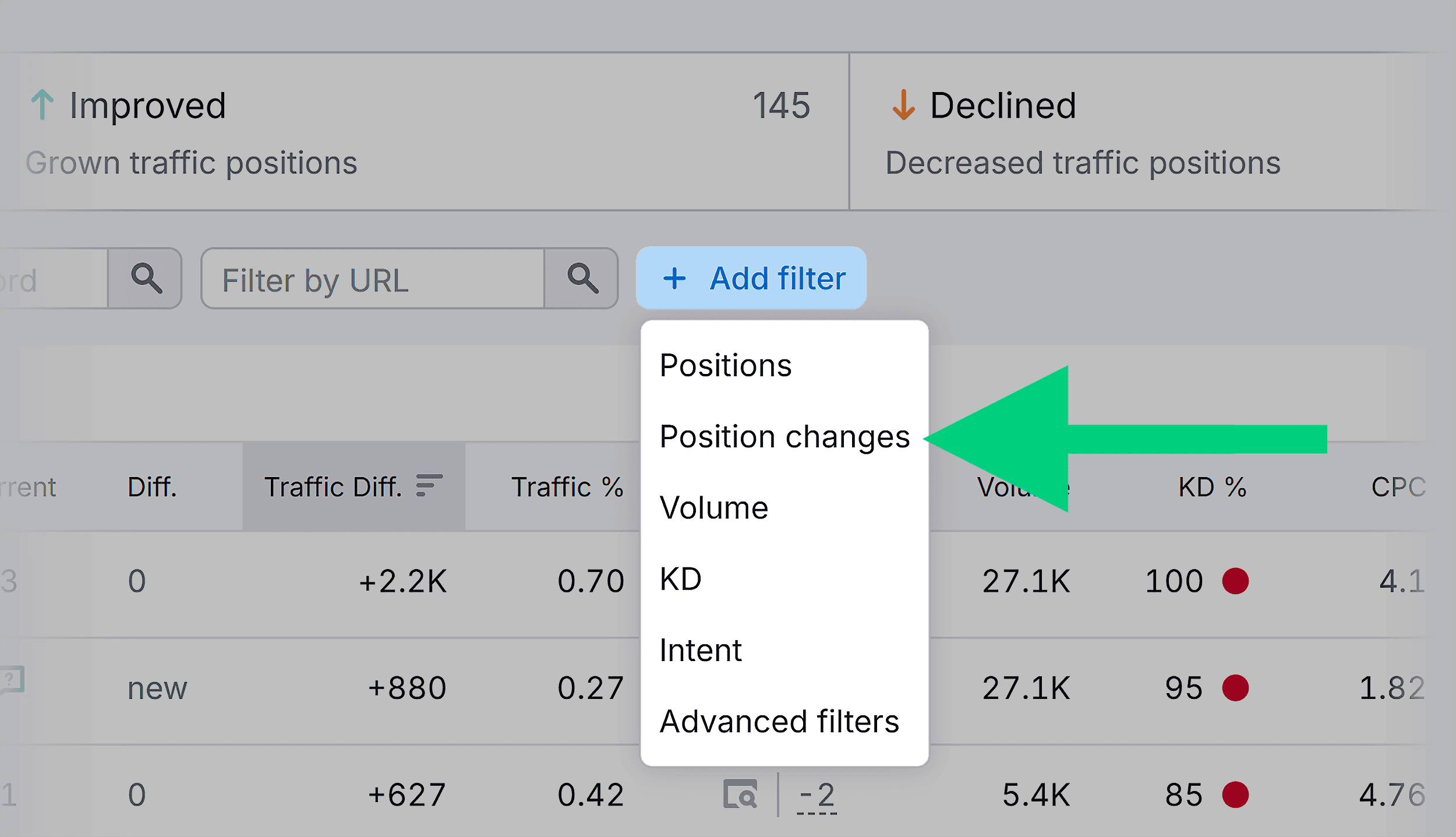
Check “Declined” and “Lost.”
Click “Apply.”
(You can also check “New” and “Improved” to see their ranking keywords instead.)

Next, switch to “Topics” on the menu to view your competitor’s highest-performing topics.
Including estimated traffic, keywords, volume, and average keyword difficulty.
Prioritize topics with at least decent search volume but lower difficulty scores.
These give you the best chance of ranking quickly.

Another helpful tool for identifying high-value topics?
Semrush’s Keyword Gap.
Enter your domain and up to four competitors’ domains. Click “Compare.”
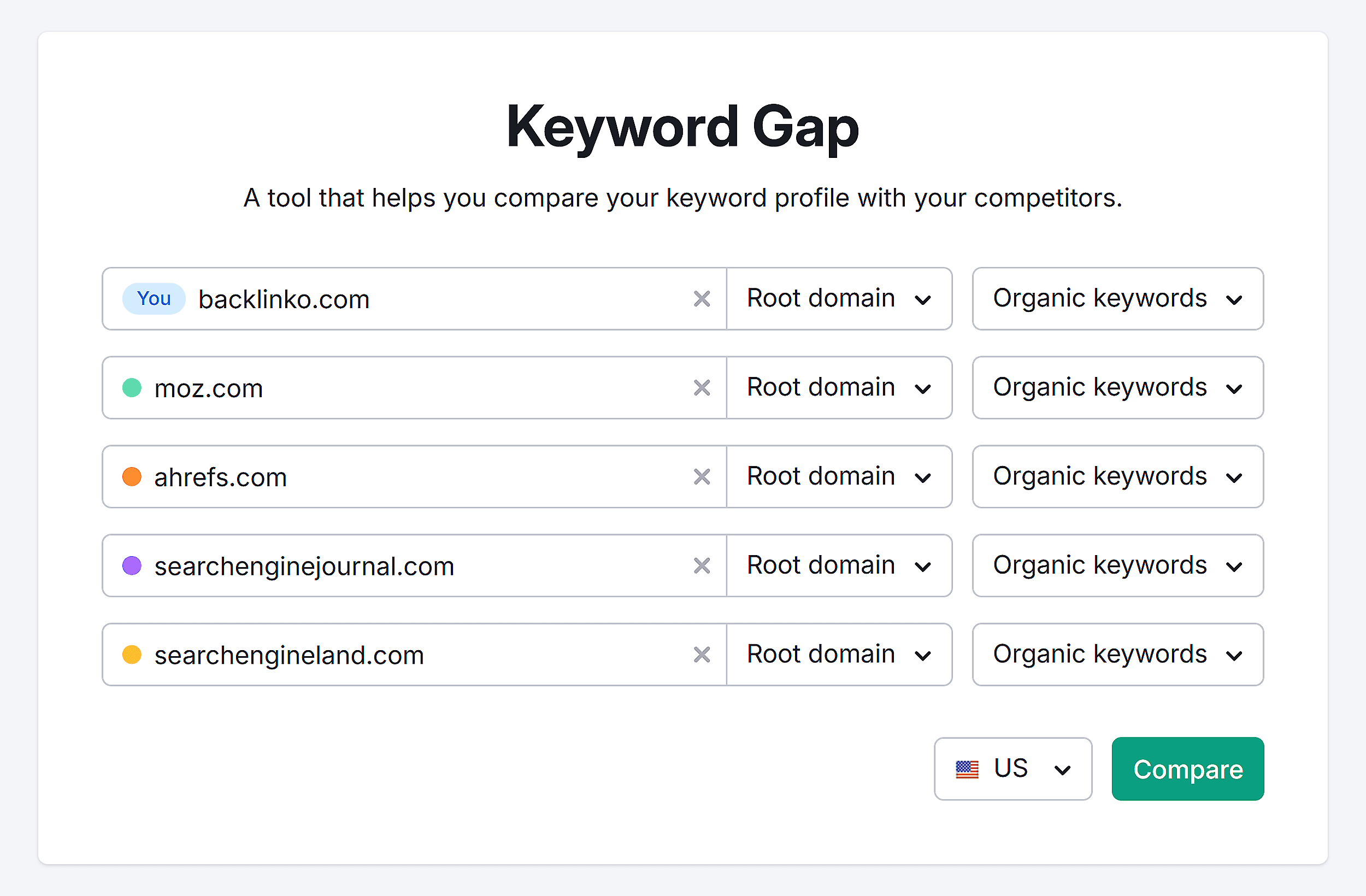
Scroll to the “All keyword details for [your site] report.”
Pay attention to the following:
- Missing: Keywords that all the other domains rank for, except you
- Untapped: Keywords that at least one of the other domains ranks for, except you

This reveals content gaps where your competitors are already succeeding.
Instead of guessing what topics might work, you’re targeting proven winners with a strategy to outrank them.
Mine Online Communities
Online communities are GREAT for finding your customers’ burning questions.
For example, say you have a recipe blog and want to create content for specific diets.
Head over to the Paleo subreddit, and you’ll notice lots of questions about dessert:

Why is this important?
Most people ask questions on Reddit because they couldn’t find their answer on Google.
Or because the answers on Google don’t feel authentic enough.
This means there’s a HUGE opportunity for you to swoop in and answer that question with your content.

Pro tip: Use AI tools to analyze thousands of Reddit threads and Quora questions in minutes. Ask AI to identify patterns in customer questions to help you spot common pain points and preferences.
These community questions should become the backbone of your content strategy in two key ways:
- Pain point mapping: Track which questions appear repeatedly to identify the biggest challenges your audience faces. Then, prioritize these topics in your content calendar.
- Content format planning: Pay attention to HOW people ask. A “how do I” question might work best as a tutorial, while “what’s the best” questions are perfect for comparison posts or roundups.
You can even create a dedicated FAQ hub on your site that directly answers these community questions.
This approach builds trust fast because you’re solving real problems your audience is actively searching for.
You can follow this same process using Quora:

You can also use Answer the Public to scale this task.

It’s a free tool that hands you popular questions that people have around your topic:

Prioritize Your Content Ideas
By now, you likely have a lot of potential topics.
Here’s how to separate the winners from the noise:
Ask yourself if the topic ties back to your product or service. Content that can’t connect to your business goals is just busy work.
Next, check for proven demand using a keyword research tool.
Prioritize topics with solid search volume, clear search intent, and manageable difficulty.
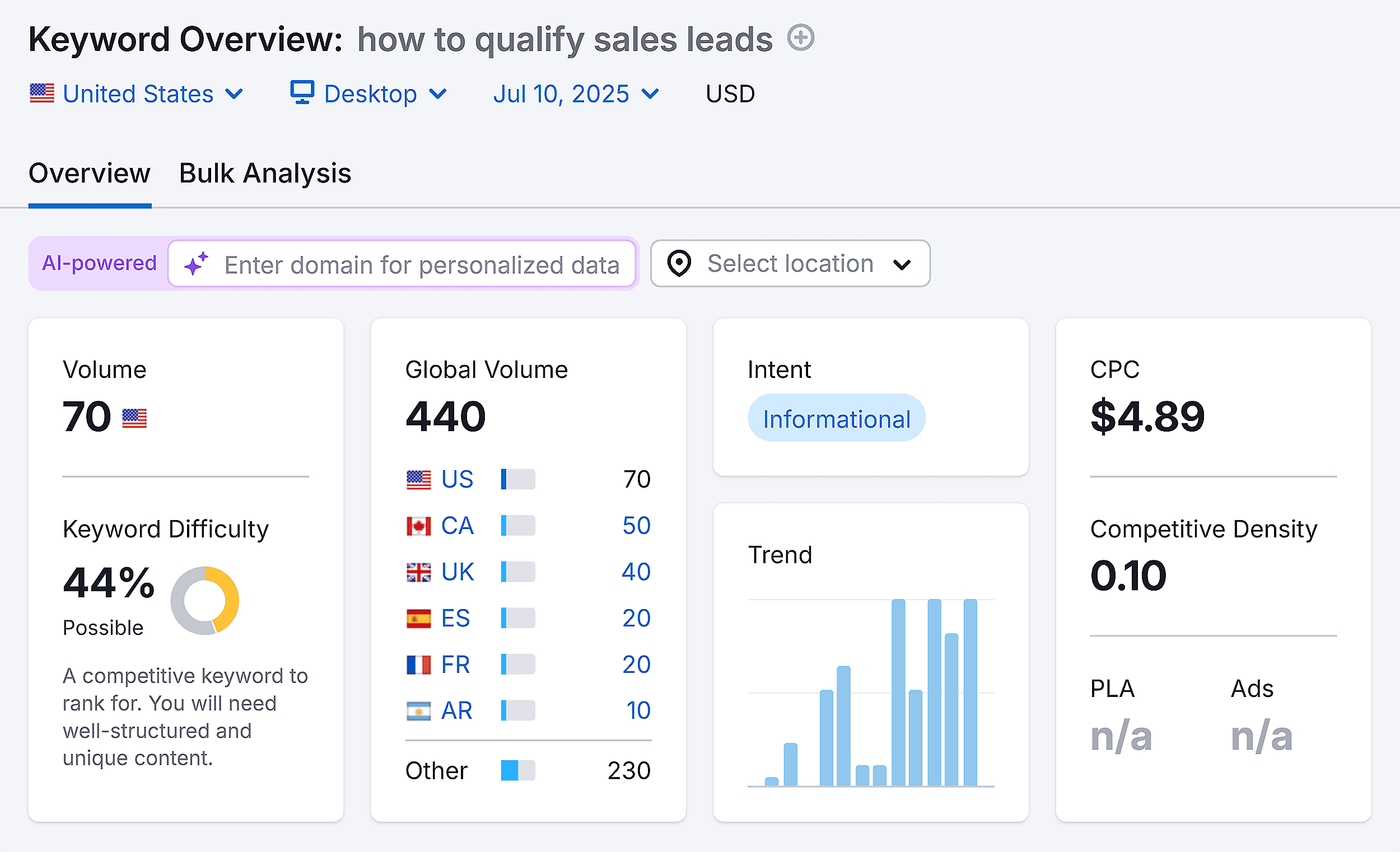
Then, consider if your team can realistically create quality content on this topic.
Do you have the expertise, resources, and time to do it justice?
Finally, think about your differentiation opportunity.
Can you add a fresh angle, better examples, or unique insights that competitors haven’t covered?
If a topic checks all four boxes, green light it.
Once you’ve validated your topics, assign each one to its corresponding awareness stage:
- Most aware topics: What questions do prospects ask right before buying? What final objections need addressing? Turn these topics into pricing guides, comparison pages, and tutorials.
- Product aware topics: Are competitors ranking for “best [solution category]” terms? Create your own version with honest comparisons and clear differentiators.
- Solution aware topics: Are people asking “how to choose” or “what type of [X]”? Build educational content that explains the options and subtly positions your solution as the best fit.
- Problem and unaware topics: What recurring pain points did you identify in your topic research? Turn those insights into content that validates the problem and builds awareness.
Pro tip: Want to reach more customers on more channels at all stages of their journey? Experiment with different content types. Try blog posts, videos, lead magnets, ebooks, infographics, success stories, interactive content, and more.
Step 3: Create Comprehensive Content Briefs
Coming up with high-impact topics is only half the battle.
The other half?
Turning those ideas into content that actually performs. That’s where a content brief comes in.
Content briefs eliminate guesswork and align your entire team on what you’re creating and why.
They prevent scope creep, reduce revisions, and ensure every piece of content serves a clear business purpose.
And they can be as short or detailed as you like.
My vote? Make them comprehensive.
The more direction you provide upfront, the less time you’ll spend on revisions.
And the more likely your content will resonate with your audience.
Every brief should include the basics. Like the topic, primary keyword, and article format.

But creating truly helpful content requires doing more than the minimum.
That’s why we include audience insights like the following in our briefs at Backlinko.
- Target audience level: Beginner, intermediate, or advanced
- Awareness stage: Where are they at in their journey?
- Primary goal: Traffic, leads, conversions, brand awareness
- Reader pain points: The challenges your audience faces
Pro tip: Ask your product, sales, and support teams to contribute to briefs. They can flag upcoming features, share common prospect questions, and identify knowledge gaps worth addressing.
This context helps writers match their tone, examples, and approach to your specific audience.
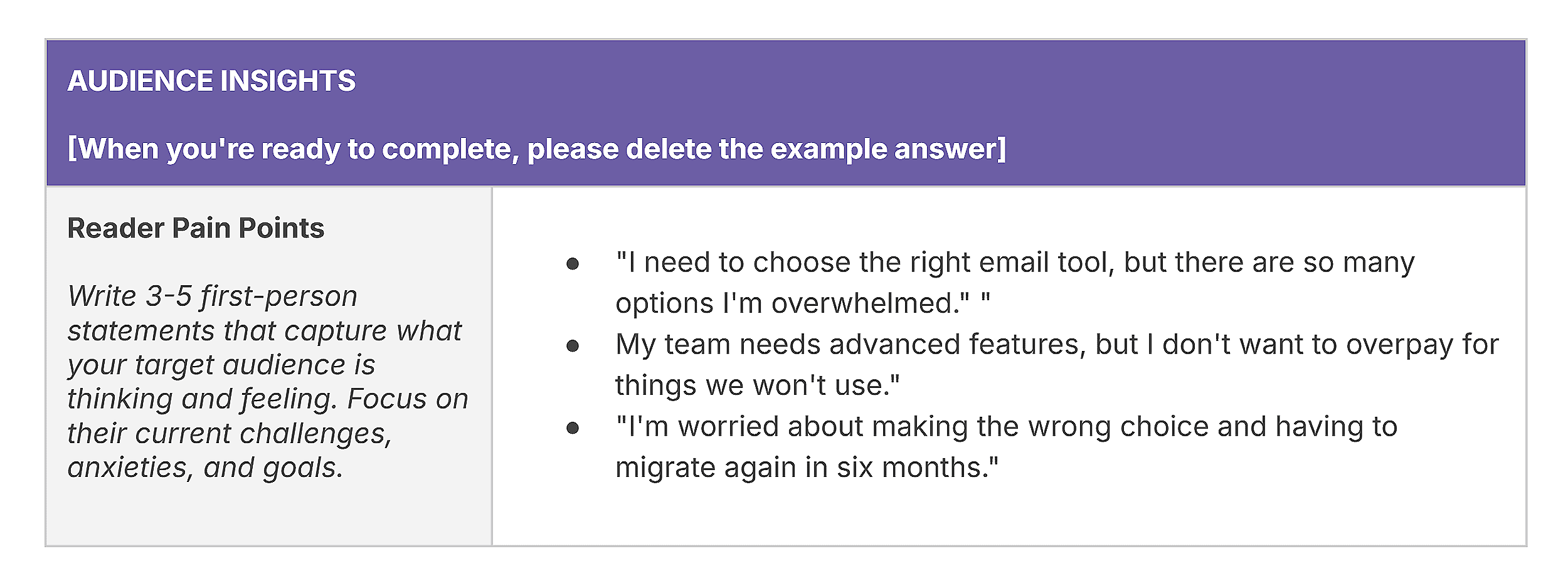
Another essential brief component? SERP analysis.
Include the most notable competitors’ URLs in the brief for writers to use as inspiration. And leave notes on any gaps you can fill to outrank your competition.
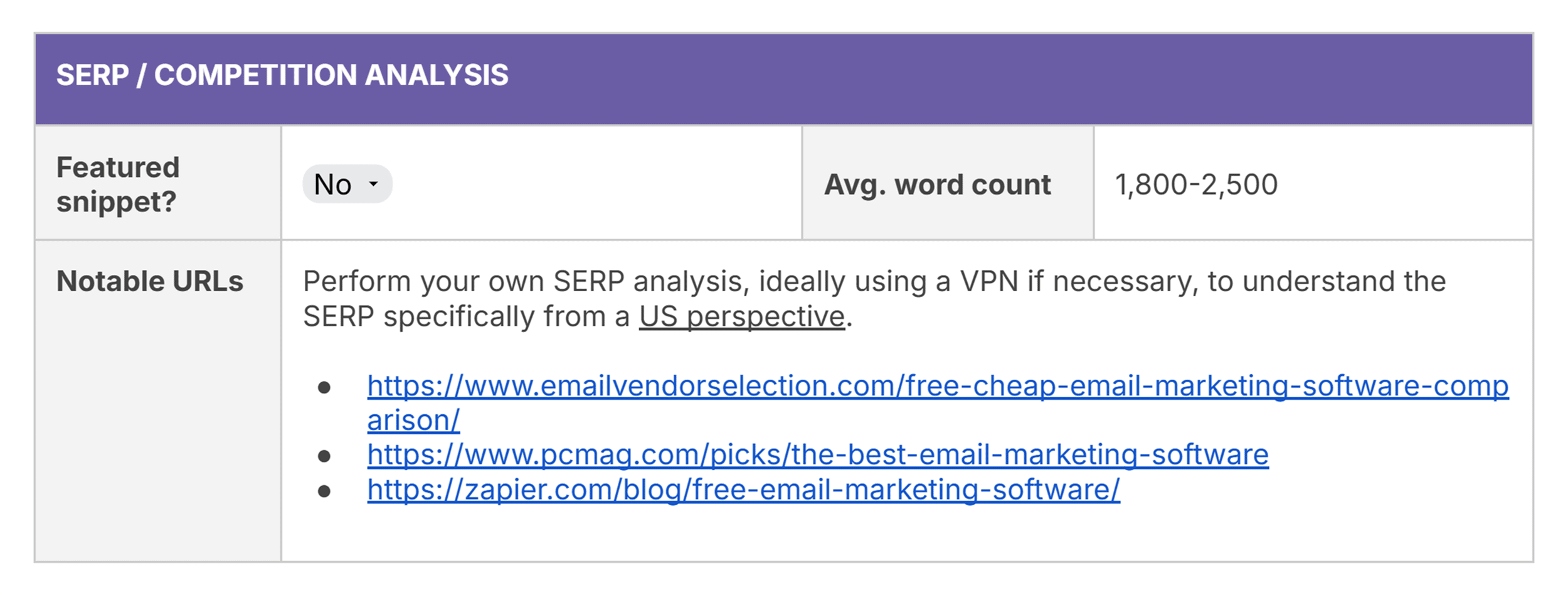
Speaking of outranking your competitors…
Every brief should include your plans for information gain.
(Aka the unique value your content will provide that readers can’t find elsewhere.)
This includes:
- Expert quotes or SME insights from industry leaders
- Original data, research, or case studies from your own experience
- Interactive tools like calculators, templates, or checklists
- Fresh angles or perspectives that competitors haven’t covered

Finally, I highly recommend baking your content repurposing plans into your brief.
Getting the most from your content efforts shouldn’t be an afterthought.
Plan to turn every article or blog post into multiple formats: social content, videos, email series, podcasts, and more.
This lets you build full-funnel coverage from day one. And ensures you maximize your investment.

Step 4: Focus on Creating Amazing Content
Here’s the reality:
It’s getting harder to make your content stand out.
The audience decides within seconds whether your content is worth their time. If you don’t grab them immediately, they’re gone.
That’s why we developed the Hook & Hold Method at Backlinko.
It helps us create content that captures (and keeps) attention.
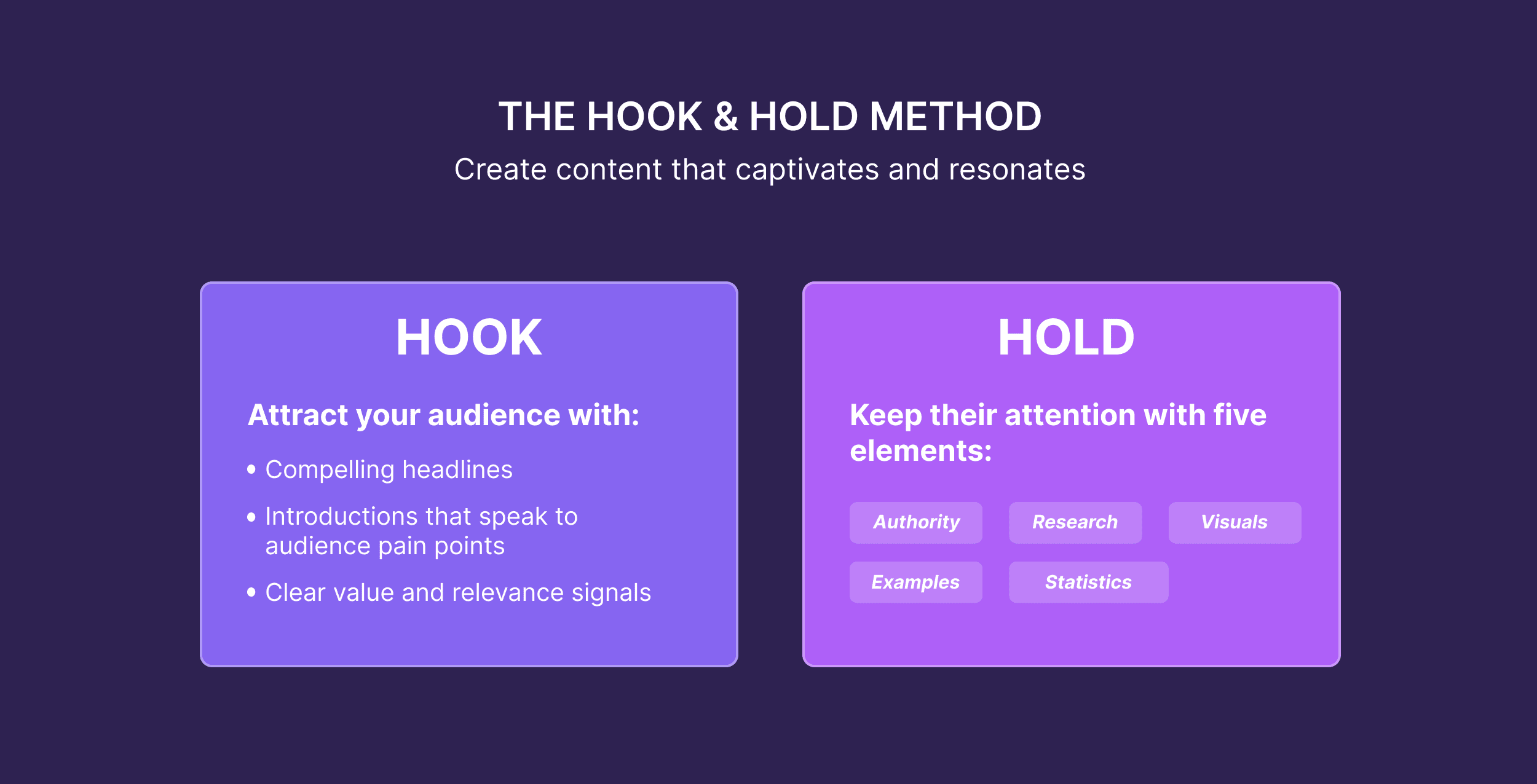
The first part of this method is the hook.
Your hook has one job: get people to start reading.
Here’s how:
- Craft a compelling headline: Use specific numbers, strong emotions, or unique angles that make people stop scrolling and click
- Start with their biggest pain point: Address what’s keeping your audience up at night in the first paragraph to create an instant connection
- Promise clear value upfront: Tell readers exactly what they’ll learn or achieve to signal immediate value and relevance
Then, you hold their attention with five key elements: Authority, Research, Visuals, Examples, and Statistics.
Let’s walk through each element.
Authority
You don’t have to be the only voice in your content.
In fact, bringing in expert perspectives builds authority and improves user experience.
Or as I like to say:
If you want an article about how to unclog a toilet, don’t hire a freelance writer.
Hire a plumber.
For example, Nerd Fitness quickly grew to be one of the most popular blogs in the fitness space.
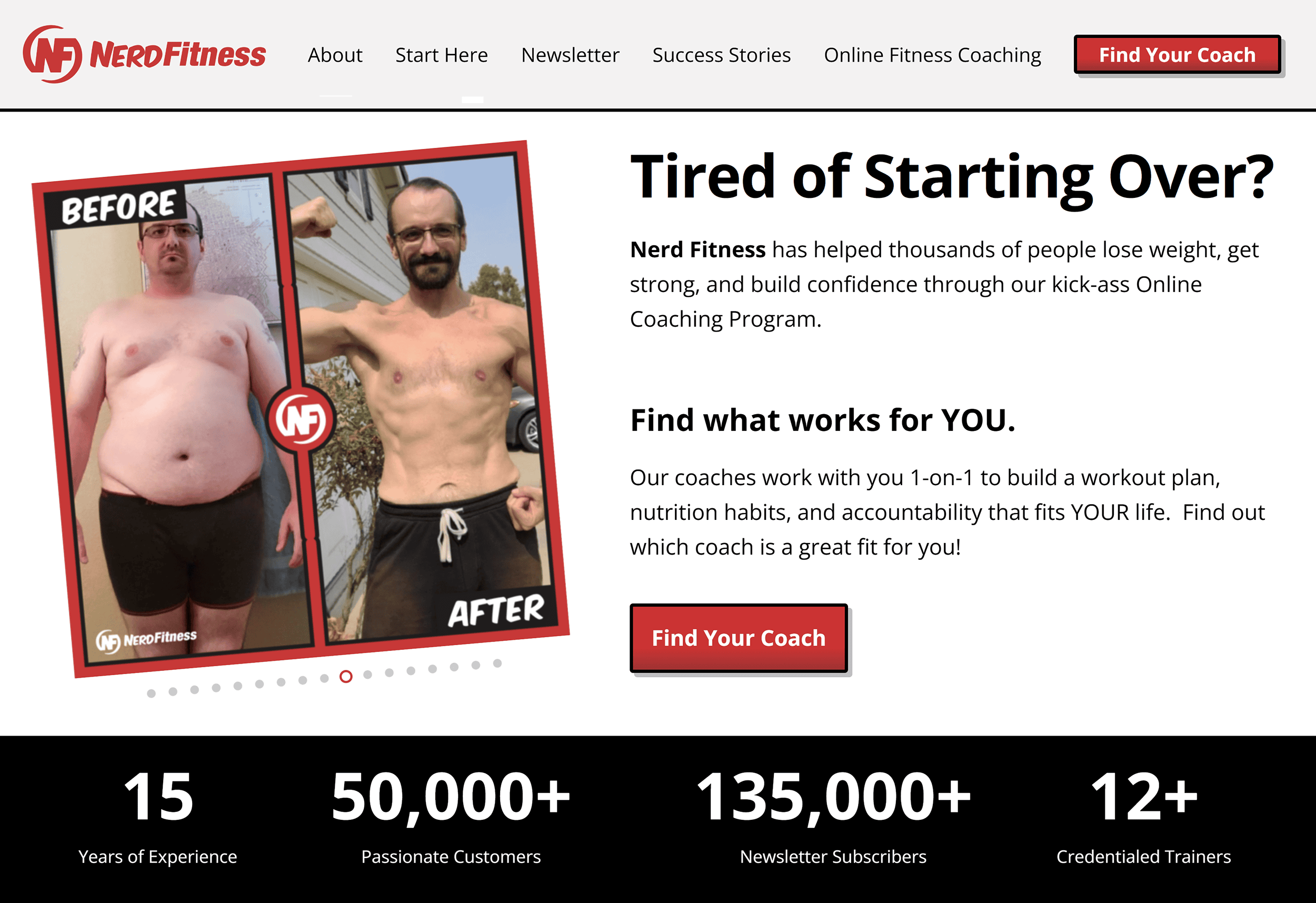
How?
Steve wrote about his personal experience of trying different diets and workout routines:
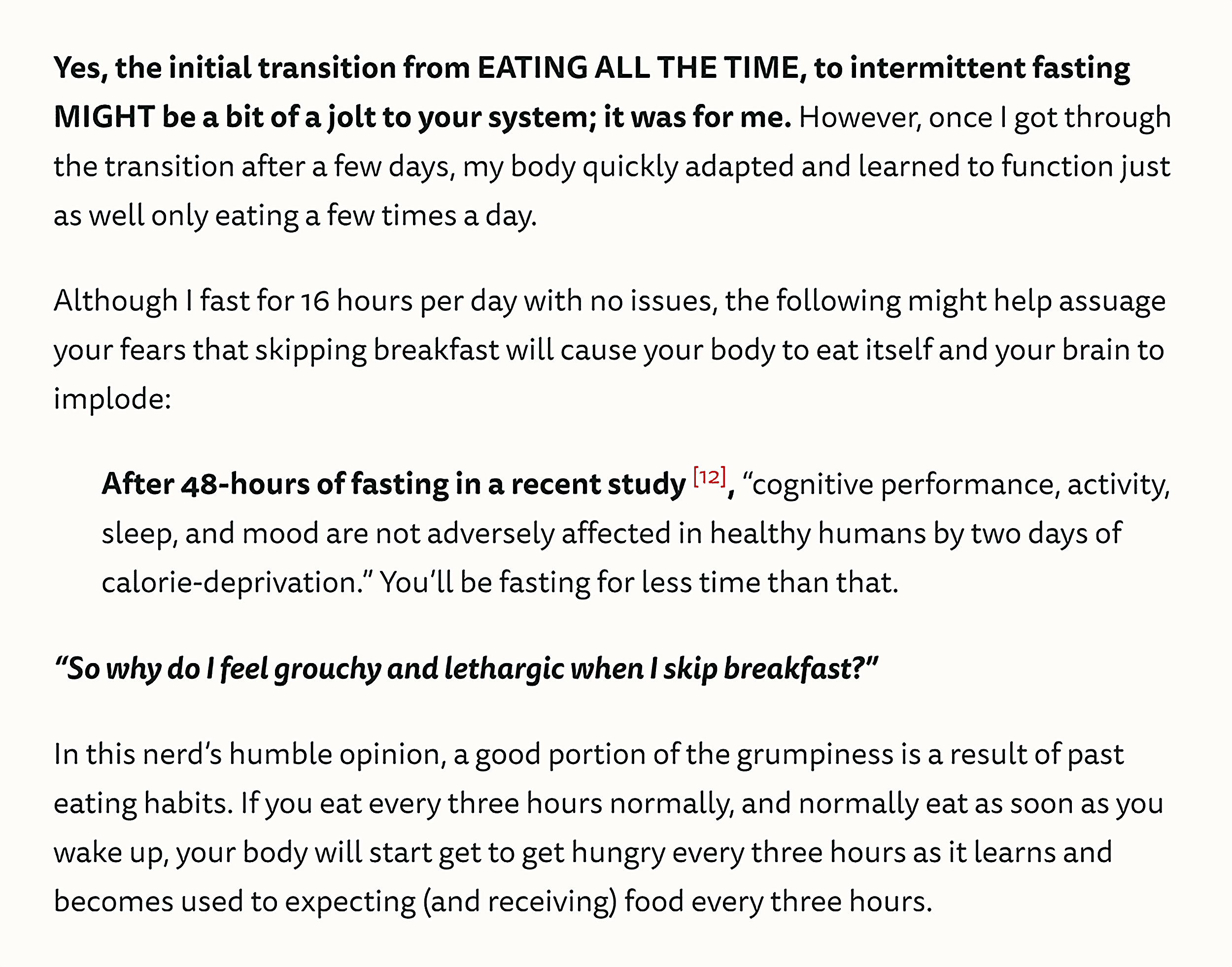
And he filled in any gaps in his knowledge with research from nutrition experts:

This demonstrated experience and expertise to their target audience and search engines.
Which then inspired trust.
And helped Nerd Fitness establish authority.
That’s E-E-A-T (experience, expertise, authoritativeness, and trustworthiness) in action.

You can also source expert insights through:
- Journalist outreach platforms like HARO or Featured
- Industry interviews, podcasts, or videos
- Social media posts from credible people in your niche
- Direct outreach to experts
Expert quotes break up visual flow while adding credibility and fresh perspectives to your content.
Pro tip: If you use AI tools to support content creation, inject original insights, quotes, and real-world examples to maintain your authority and trust.
Research
Great content is built on great sources.
While trustworthy sources vary by industry, prioritize these sources as a general rule:
- Academic research and peer-reviewed studies
- Government data (.gov sites)
- Industry surveys from recognized research firms
- Industry-leading websites and blogs
- Company earnings calls and official statements
Fill in knowledge gaps with expert insights and quotes.
At Backlinko, we often feature expert input from industry veterans to add unique insights and authority to our content.
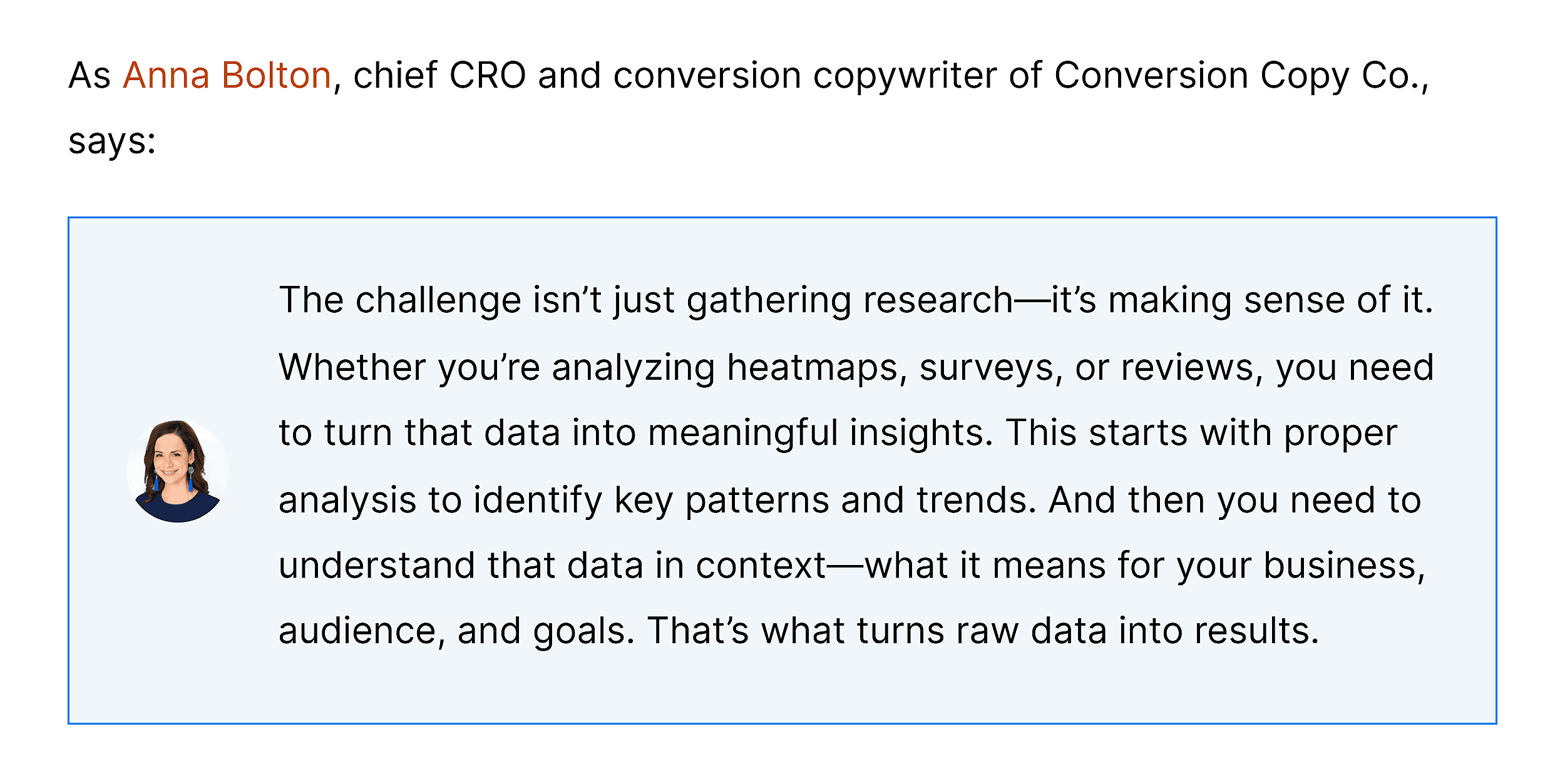
Visuals
There’s no way around this:
If you want people to read and share your content, it needs to look GREAT.
This is why we go the extra mile to use high-res screenshots.
These crisp, annotated screenshots prove you’ve actually done what you’re teaching.
And make complex processes instantly understandable.
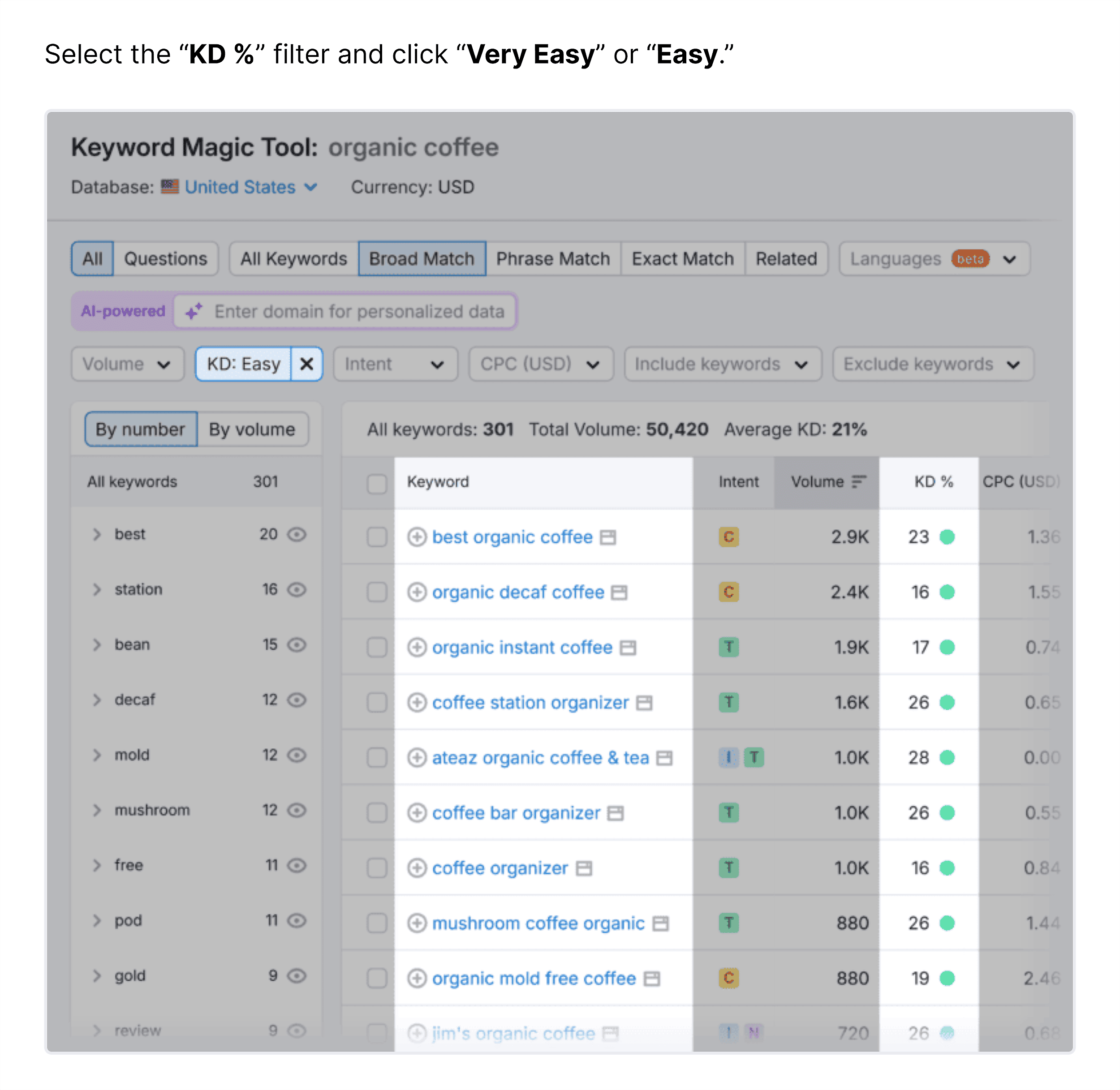
Charts and data visualizations transform boring numbers into compelling stories that support your key points and make them stick.
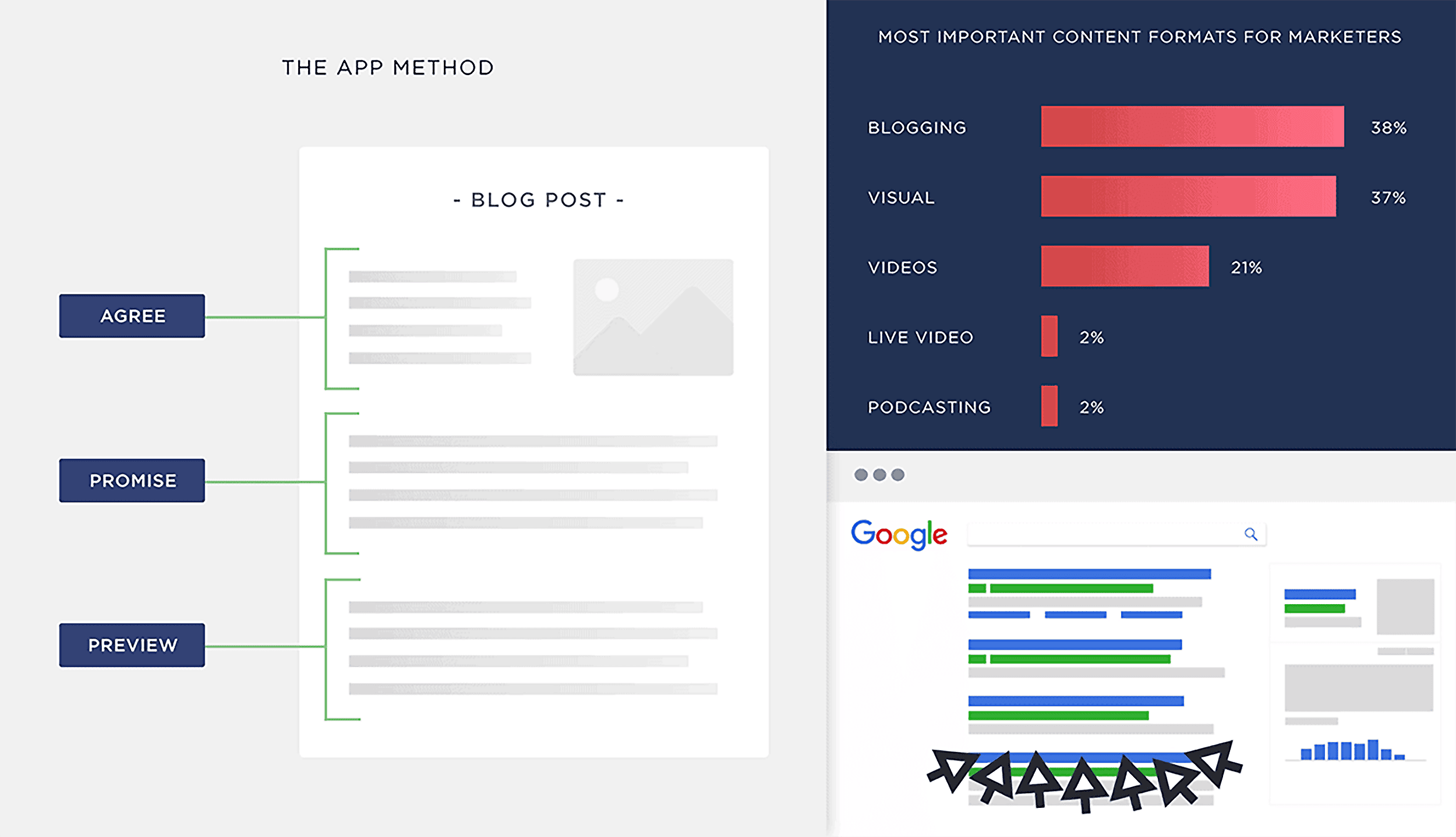
We also use custom-designed guides to differentiate my content from competitors.
And boost perceived value.
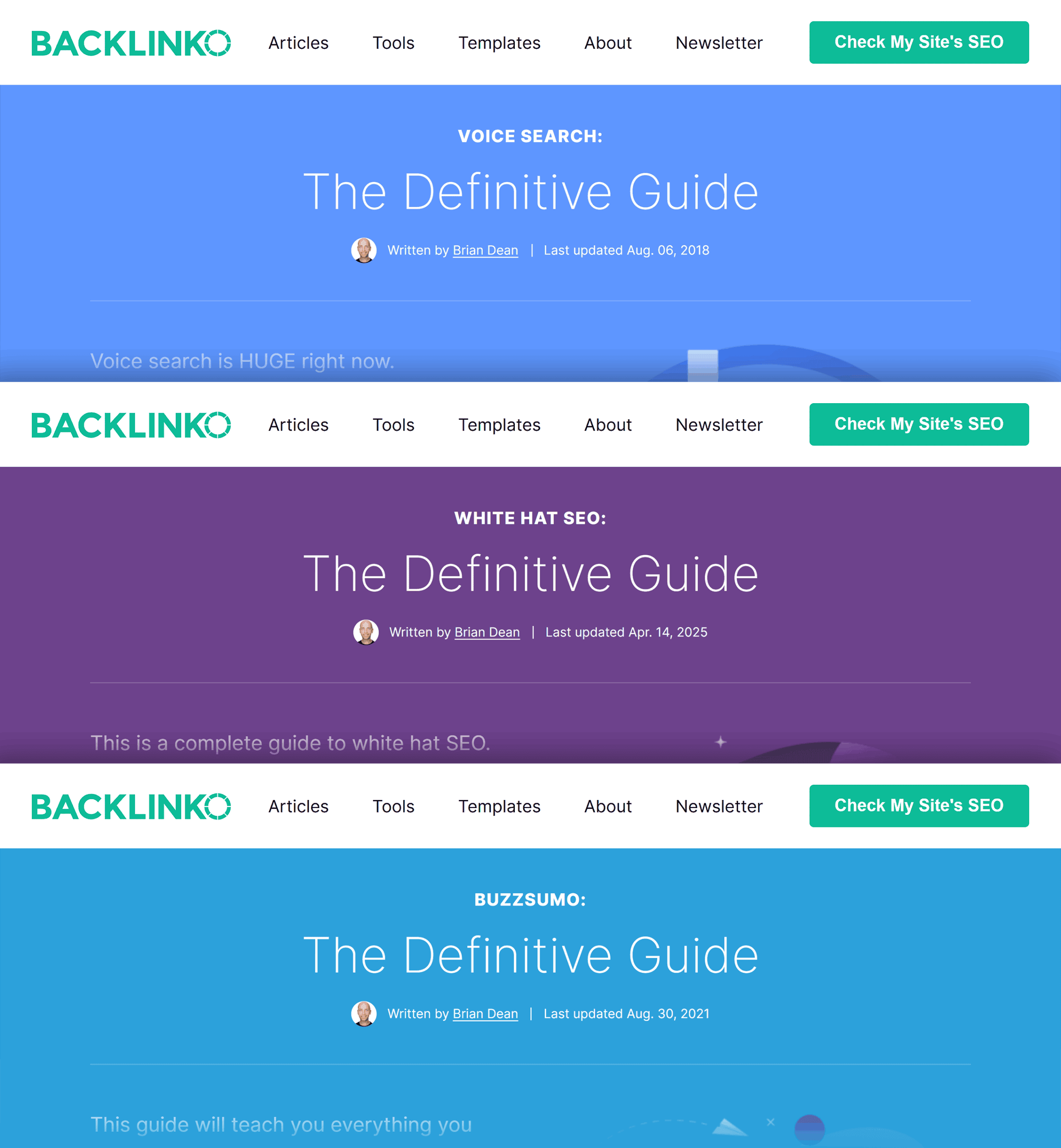
Examples
When it comes to content, there’s one thing I’ve found to be true almost 100% of the time:
People LOVE examples.
When you hear the words “for example,” your brain breathes a sigh of relief.
It makes learning easier and more relatable.
That’s why we include TONS of examples in every post:
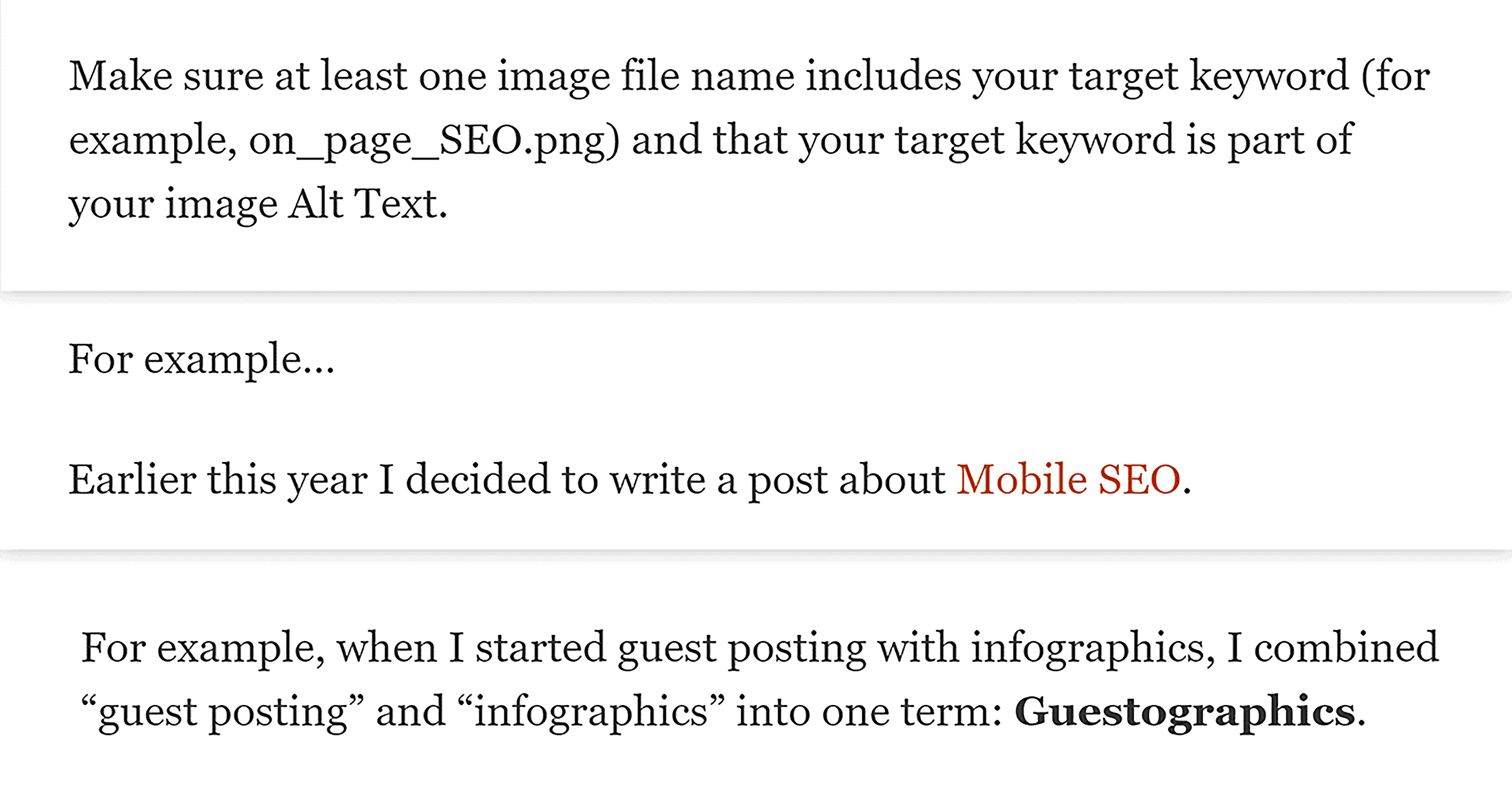
Including examples makes your content easier to understand.
But it also signals E-E-A-T to readers and Google.
Even better? AI can’t replicate it.
When you share specific examples, you demonstrate real-world experience that generic content simply can’t match.
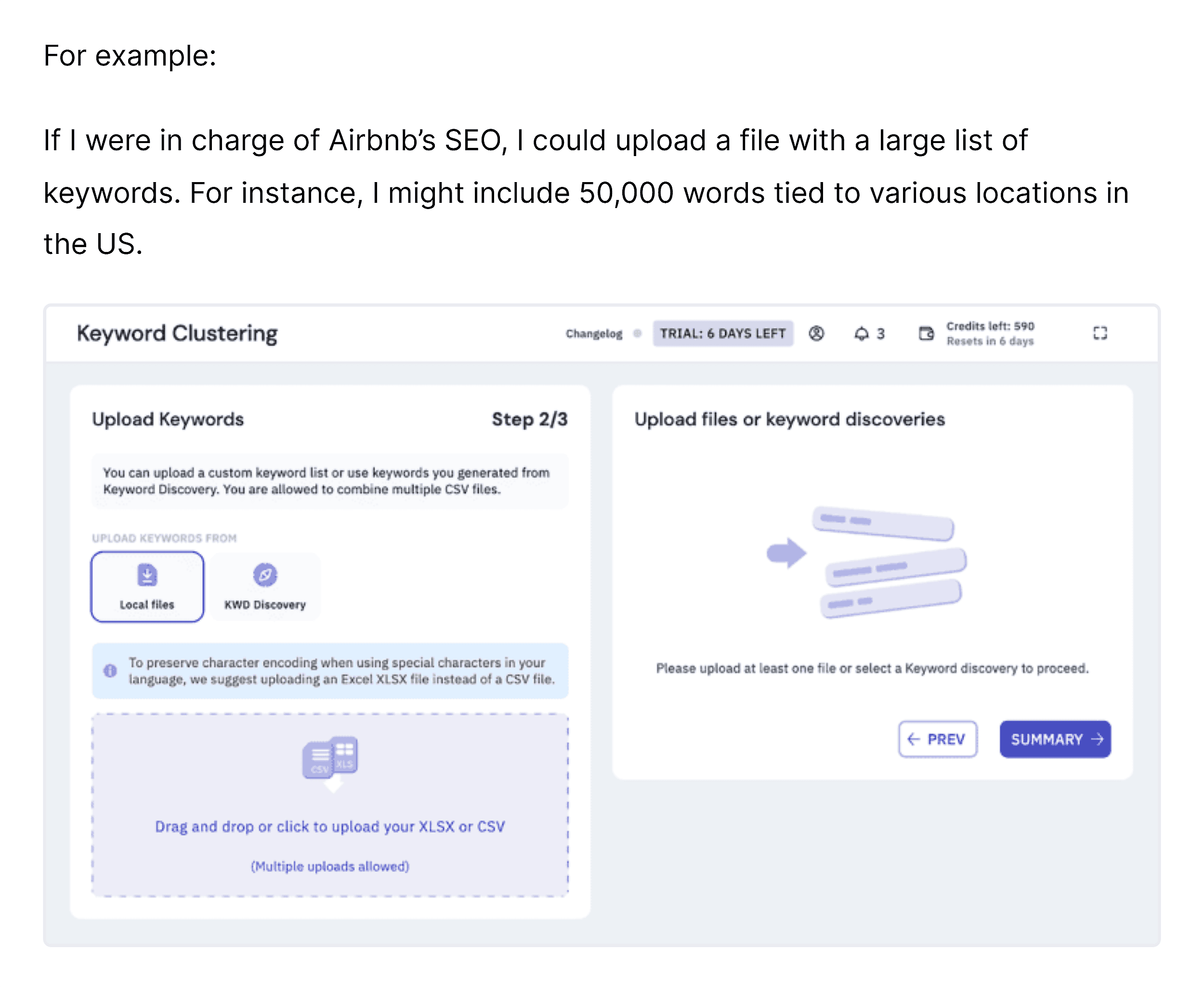
Does adding examples take more work than simply saying, “do this”?
Sure.
Is it worth it?
Definitely.
Statistics
Nothing builds credibility faster than strong statistics.
When you back up claims with data from reputable sources, it sends trust signals to both readers and Google.
But not all statistics are created equal. The key is finding data that’s both credible and compelling.
Original data works even better than citing existing studies.

Whether it’s a full-scale study or a LinkedIn post, it attracts readers and backlinks.
And gives you a serious competitive edge.
Here are the best ways to source original data:
- Conduct surveys of your audience or industry
- Analyze your customer data for trends and insights
- Compile industry benchmarks from multiple sources
- Track performance metrics over time
- Interview experts and quantify their insights
Pro tip: Don’t focus solely on new content in your strategy — revisit and refresh older posts, too. Add new stats, update examples, and optimize for today’s search behavior to give them a second life.
Step 5: Promote Your Content
Without strategic promotion, even your best content might never reach your target audience.
The question is: How do you promote your content the right way?
Here are a few simple strategies that actually work.
Create Email Newsletters
This is HUGE.
An email list is the #1 content promotion tool on the planet. Period.
In fact, there isn’t even a close second.
Remember:
Your subscribers are made up of people who LOVE your stuff.
In other words:
They’re people who are very likely to spread the word about your content.
That’s why we share most of our posts with our email subscribers:
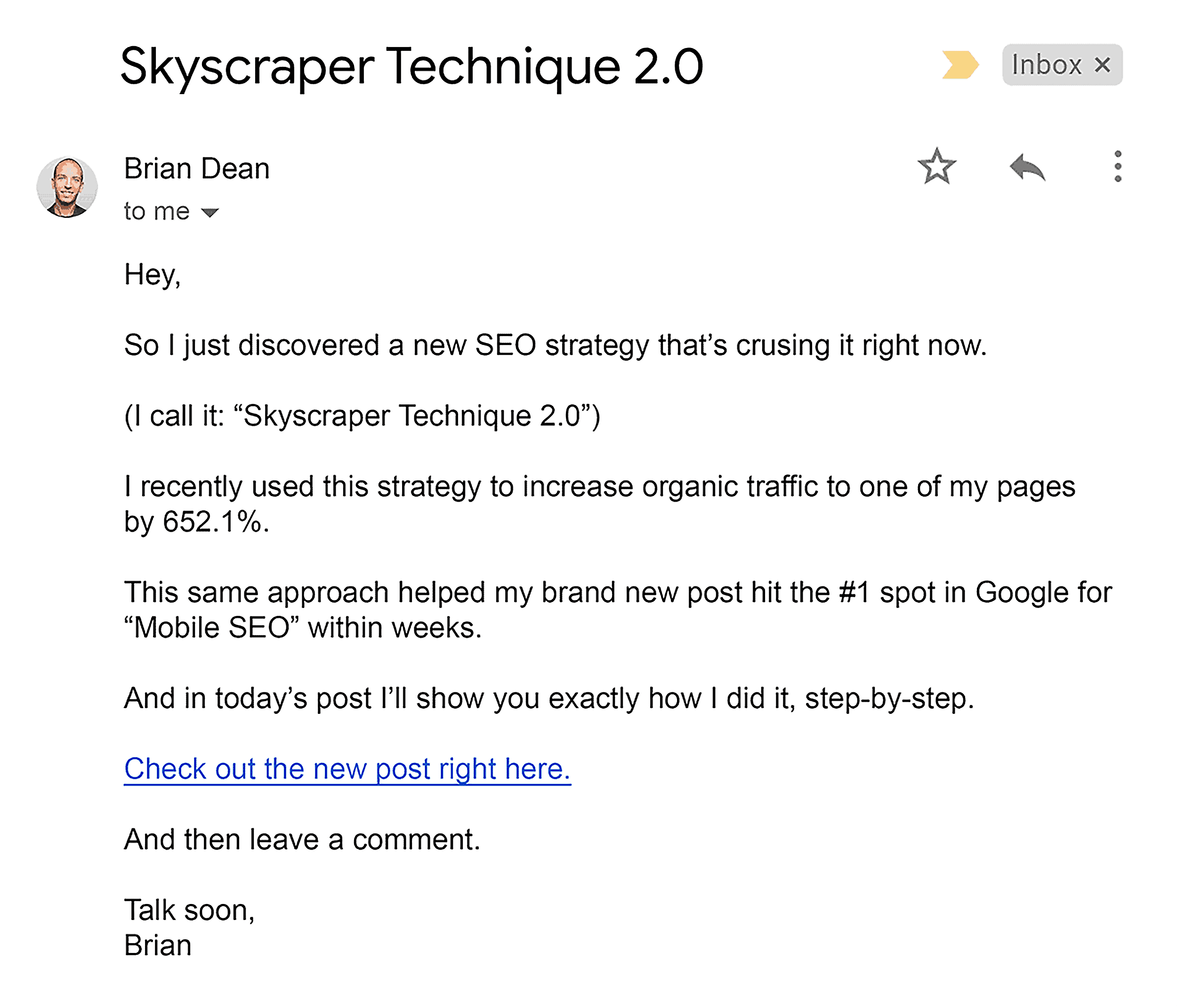
As you can see, our email doesn’t look like a stuffy corporate newsletter.
In fact, the email looks like it could be from a friend.
This is EXACTLY how you want your emails to look.
So, how did it do?
That single email generated 14,067 total visitors:
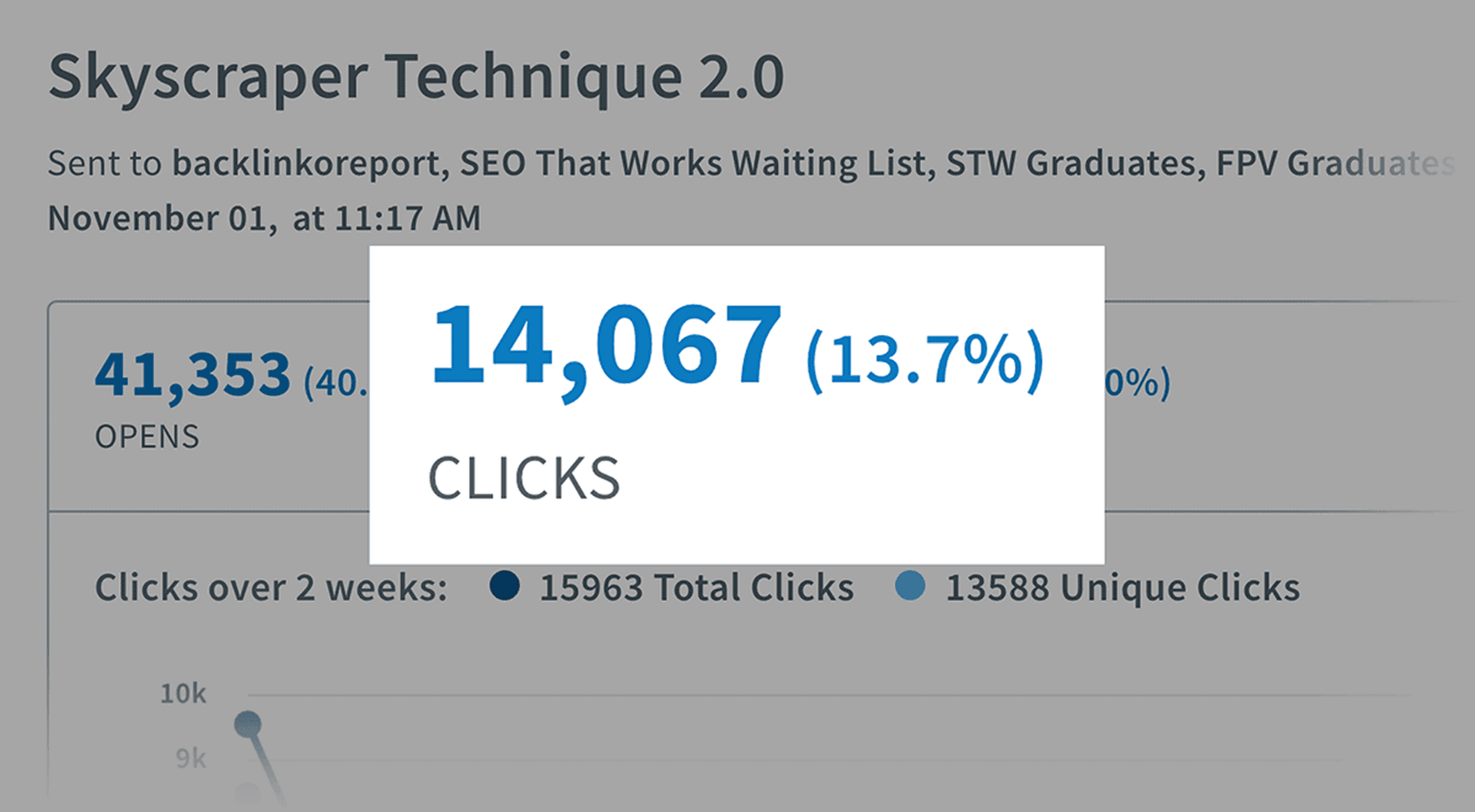
Nice!
Curate Content Roundups
In case you’re not familiar with them, roundups are posts that curate (or “round up”) awesome content from the week.
The best part?
There are roundups in almost every niche, shared everywhere from social media to email marketing.
For example, this is a LinkedIn roundup from the digital marketing niche:
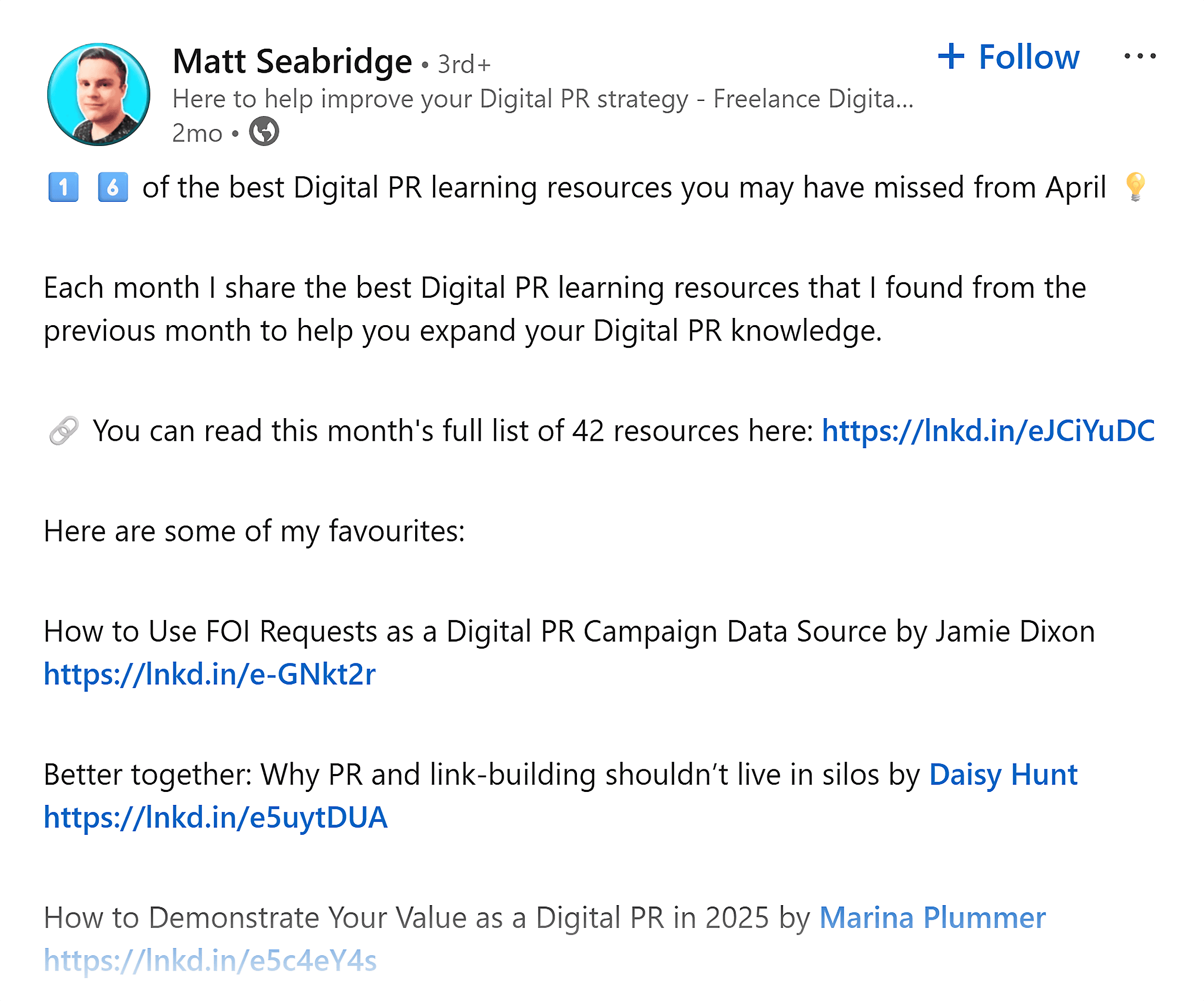
Here’s why promoting your content to link roundups works so well:
Your pitch actually makes their life easier (yes, really).
I’ll explain…
Roundup curators struggle to find content to include in their roundup.
And when you suggest your new post, you deliver awesome content on a silver platter.
This means there’s no arm-twisting required to get a link.
For example, here’s a LinkedIn roundup that featured one of Backlinko’s articles:
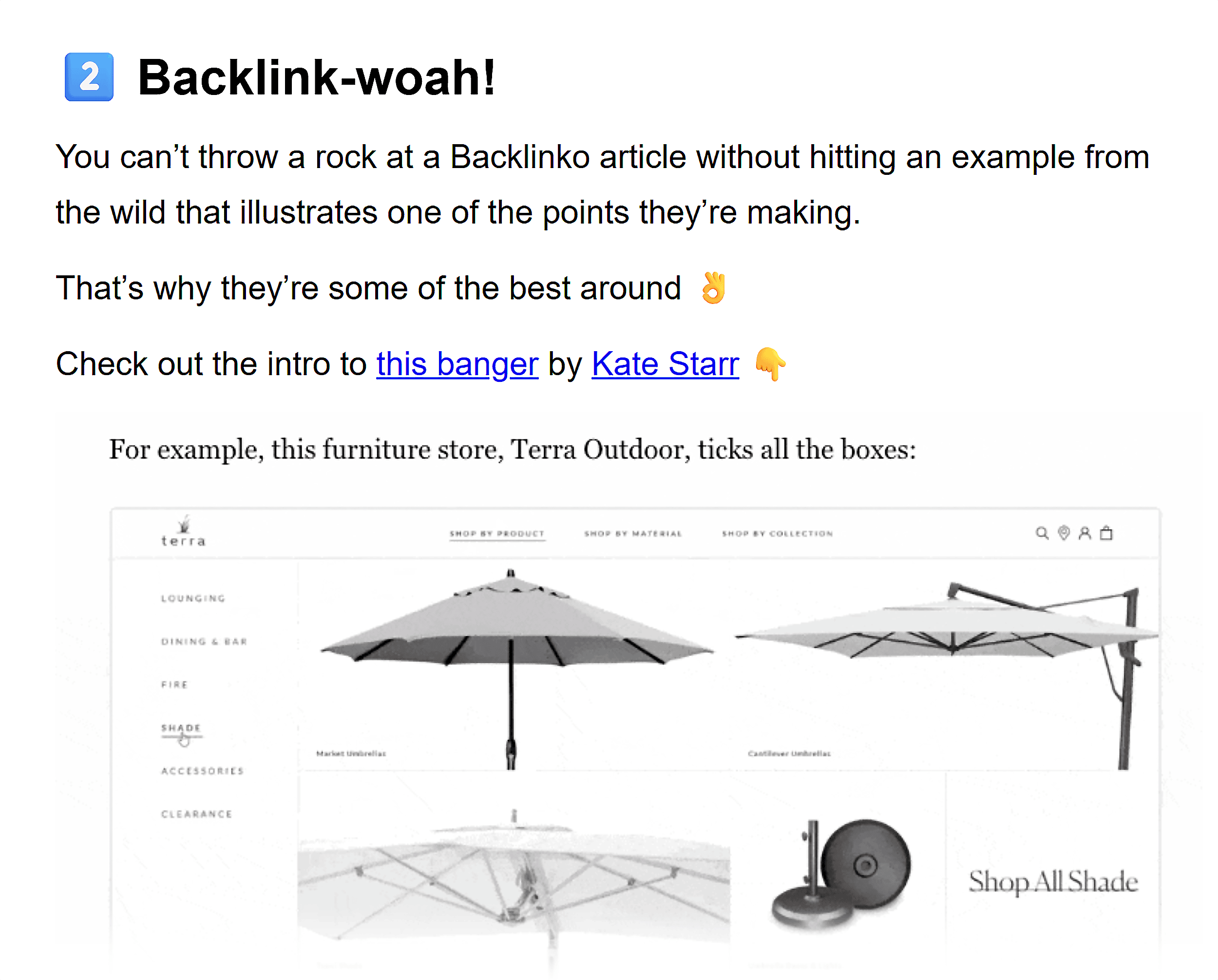
Step 6: Track and Measure Performance
Now it’s time to see how well your content strategy is working.
The question is: How do you know if your content “worked”?
The key is organizing your metrics into two categories that actually matter: business impact and engagement.
Business Impact Metrics
These metrics directly connect to revenue and business growth.
Conversions and Revenue
ROI. Business goals. KPIs.
Whatever you want to call it.
Basically, you’re answering the question:
Is content helping us get more sales?
Measure conversions in Google Analytics.
And consider creating goals for each awareness level.

For example:
- Most Aware content: Demo requests, pricing page visits, free trials
- Product Aware content: Comparison page visits, feature page engagement
- Solution Aware content: Guide downloads, newsletter signups
- Problem/Unaware content: Blog subscriptions, social follows
If you see conversions moving up, it’s probably a sign that your content marketing is working.
So, you want to add more of that content type to your editorial calendar.
That said:
It’s sometimes hard to track content’s indirect sales impact.
For example:
Brian Dean’s (Backlinko’s founder) conversions that come directly from YouTube were super low:
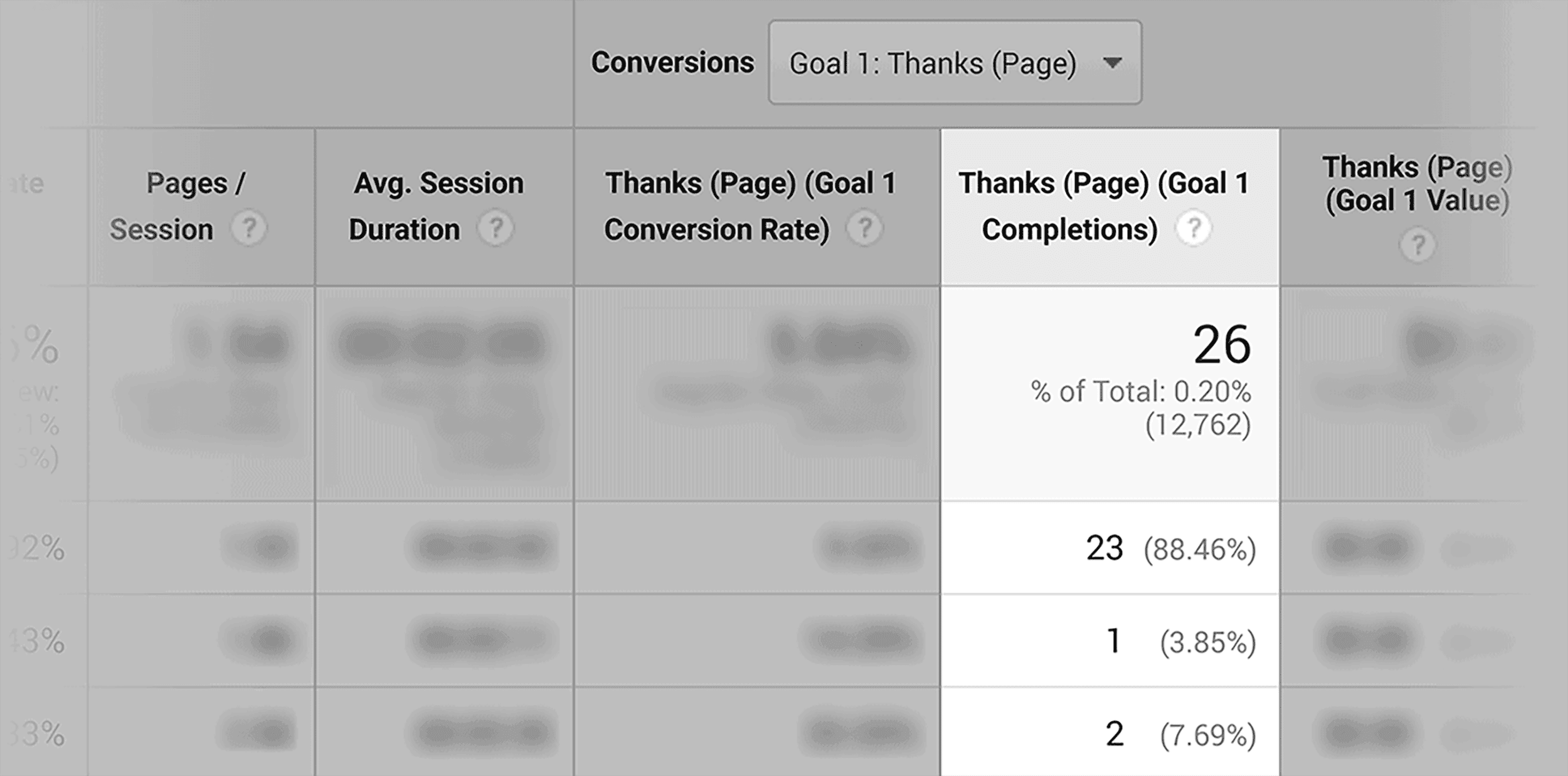
And if he ONLY looked at Google Analytics, he’d probably say: “YouTube is a waste of time.”
But when he dug a little bit deeper, he could see that his YouTube channel was a HUGE driver of subscribers and sales.
Customers cite his YouTube channel as the main reason that they decide to make a purchase:
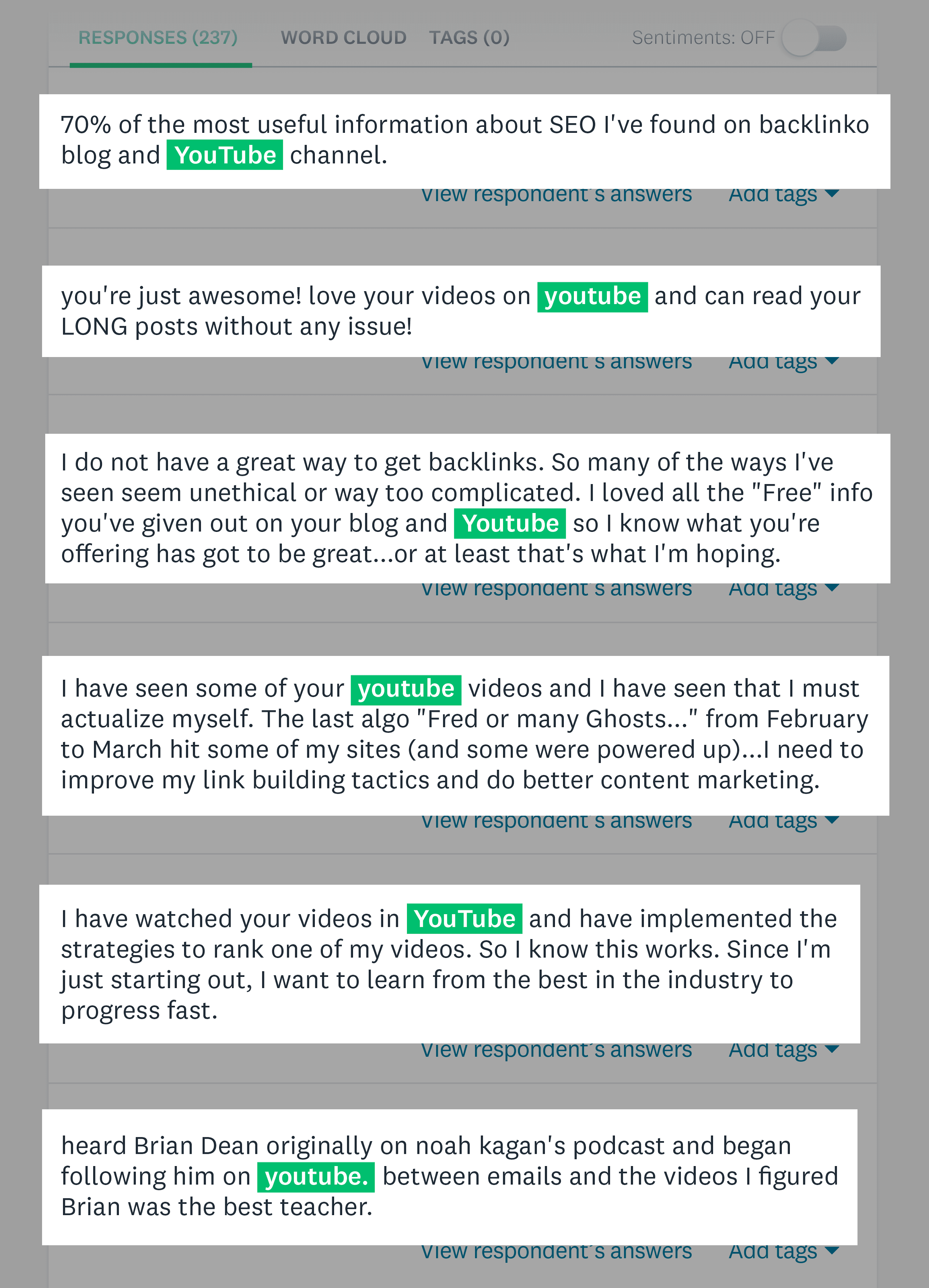
This shows that YouTube content is paying off.
Leads Generated
Not all leads are created equal.
Track qualified leads your content generates — people who fit your customer personas and have buying potential.
For example, use UTM parameters on content links to see which pieces drive the most leads.
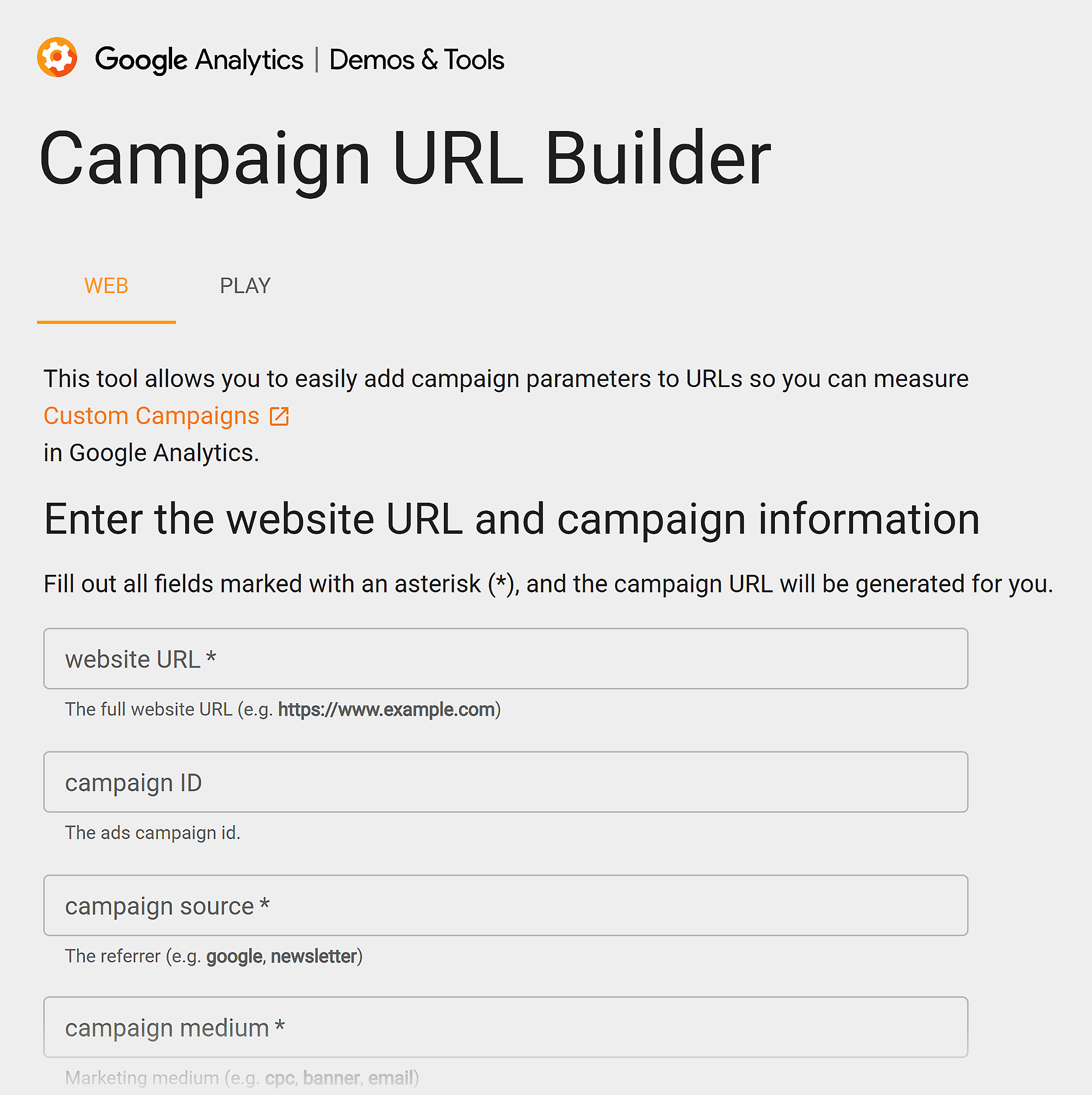
If you have a CRM, tag leads by source, so you know which content influenced them.
And score leads based on engagement. Did they read one post or download three guides?
Connect this back to the awareness stages from Step 1:
- Most Aware content should generate high-intent leads ready for sales conversations
- Product Aware content should generate leads actively evaluating solutions
- Solution Aware content should generate leads seeking education and guidance
- Problem/Unaware content should focus on list building and brand awareness
If your content isn’t generating the right leads for its stage, reassess the intent and quality.
Traffic Quality
Raw traffic numbers mean nothing if visitors bounce immediately.
Focus on engaged traffic — people who actually consume your content and take the next steps.
Key metrics to track:
- Pages per session: 2+ indicates genuine interest
- Average session duration: Benchmark against your industry average
- Bounce rate by content type: Identify which formats keep people engaged
- Return visitor rate: Shows you’re building an audience, not just attracting one-time visitors
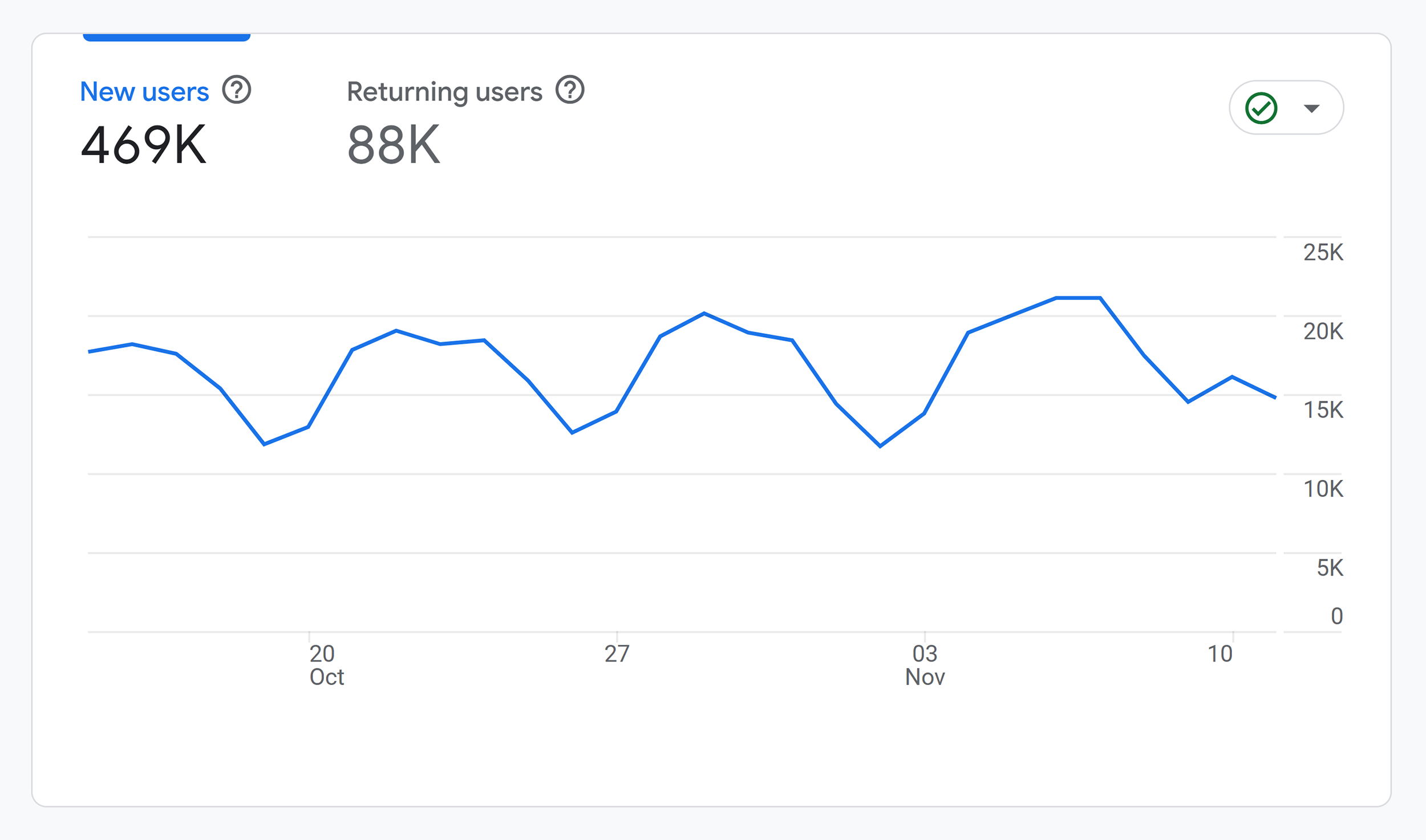
That said:
Content marketing and SEO can take time to kick in.
For example, look at the traffic numbers from the early days of Backlinko:

As you can see, it took about six months for things to really take off.
And if we gave up early on because content “wasn’t working,” we wouldn’t have seen the huge traffic spike that got us going:

Backlinko has only continued to grow since.
Persistence pays off when you combine strategic content with consistent execution.
Engagement Metrics
These metrics show how well your content resonates with your audience and predicts future business impact.
Views and Reach
Track how many people your content reaches across different platforms and channels.
What to track:
- Platform-specific reach: YouTube views, LinkedIn post impressions, blog sessions
- Audience quality: Use analytics to see if viewers match your ideal customer profile
- Cross-platform performance: Which channels drive the most engaged traffic to your site
Search Visibility and Rankings
Search visibility is more volatile than ever.
But position tracking remains crucial for monitoring your content’s performance.
Here’s what to monitor:
- Keyword clusters: Are you ranking for related terms beyond your primary keyword?
- Featured snippets: Track snippet wins and losses and identify opportunities using a tool like Semrush’s Position Tracking
- SERP features: Monitor video carousels, image packs, and People Also Ask boxes
- Click-through rates: Use Google Search Console to see if higher rankings actually drive more clicks
- LLM appearances: Are LLMs driving people to your site? Check Google Analytics’ traffic acquisition report to see referral traffic from ChatGPT and other AI platforms.

Further reading: Search Everywhere Optimization Guide + Free Checklist
Time Spent and Watch Time
Monitor how long people stay engaged with your content.
High engagement time signals that your content provides real value.
For example, check your average engagement time per blog post.
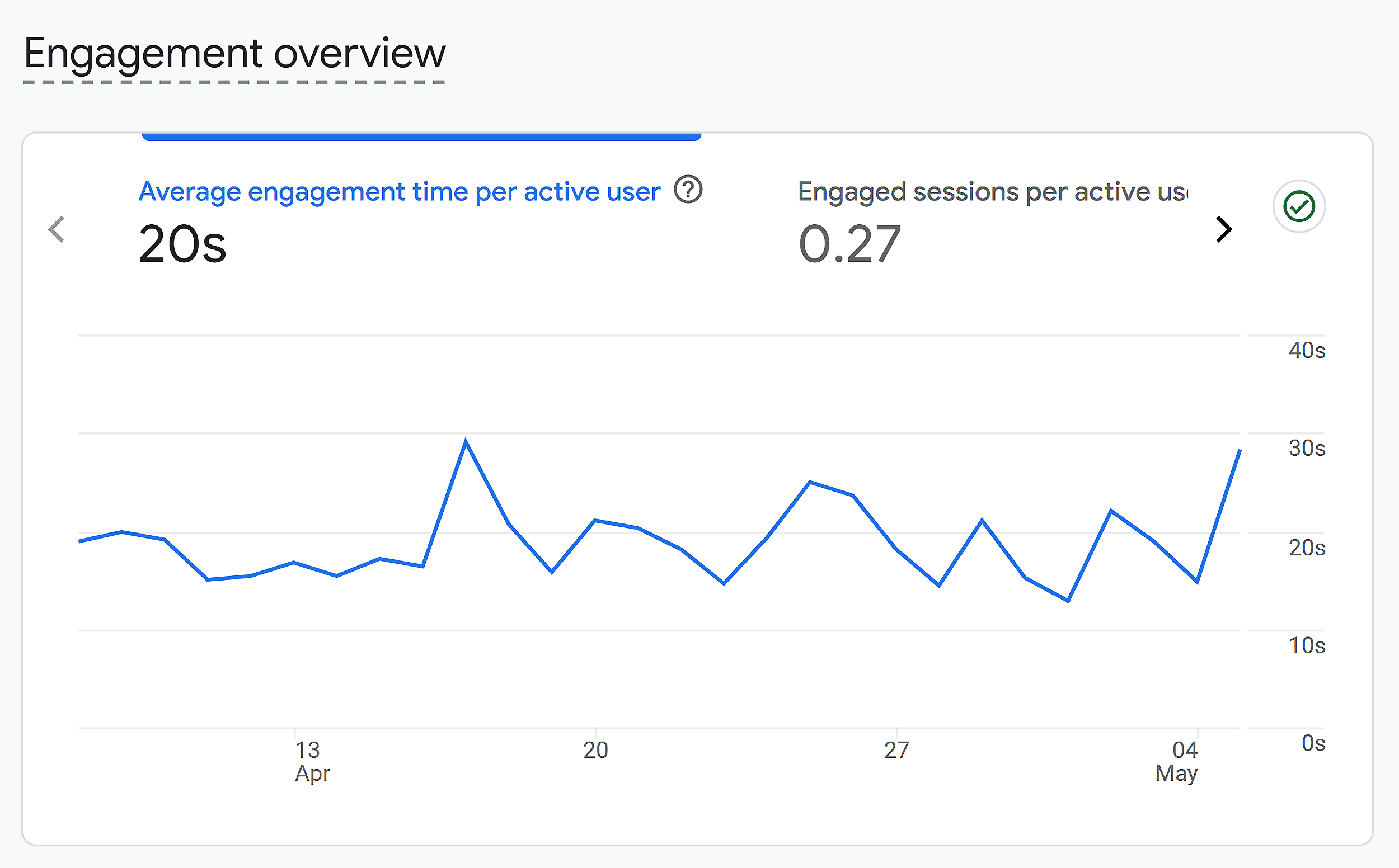
Compare your top performers to identify patterns in the topics that resonate most with your readers.
If you’re on YouTube or another video platform, monitor watch time and audience retention. This will tell you where viewers drop off to improve future videos.
Use this data to find your stickiest topics. Pay attention to the subjects that make people read multiple pages or watch entire videos.
If engagement drops at specific points, you know where to strengthen your content.
Further reading: How to Measure SEO Performance and Results
Audience Interaction
The best content gets people talking, sharing, and coming back for more.
Start by looking at the comments on your blog, videos, and social media posts.
Comments that ask follow-up questions or share personal experiences signal real engagement, not just passive scrolling.

Then, check the native analytics data for any social platforms you’re on.
For example, Pinterest tells you how many times your pins are saved to boards.
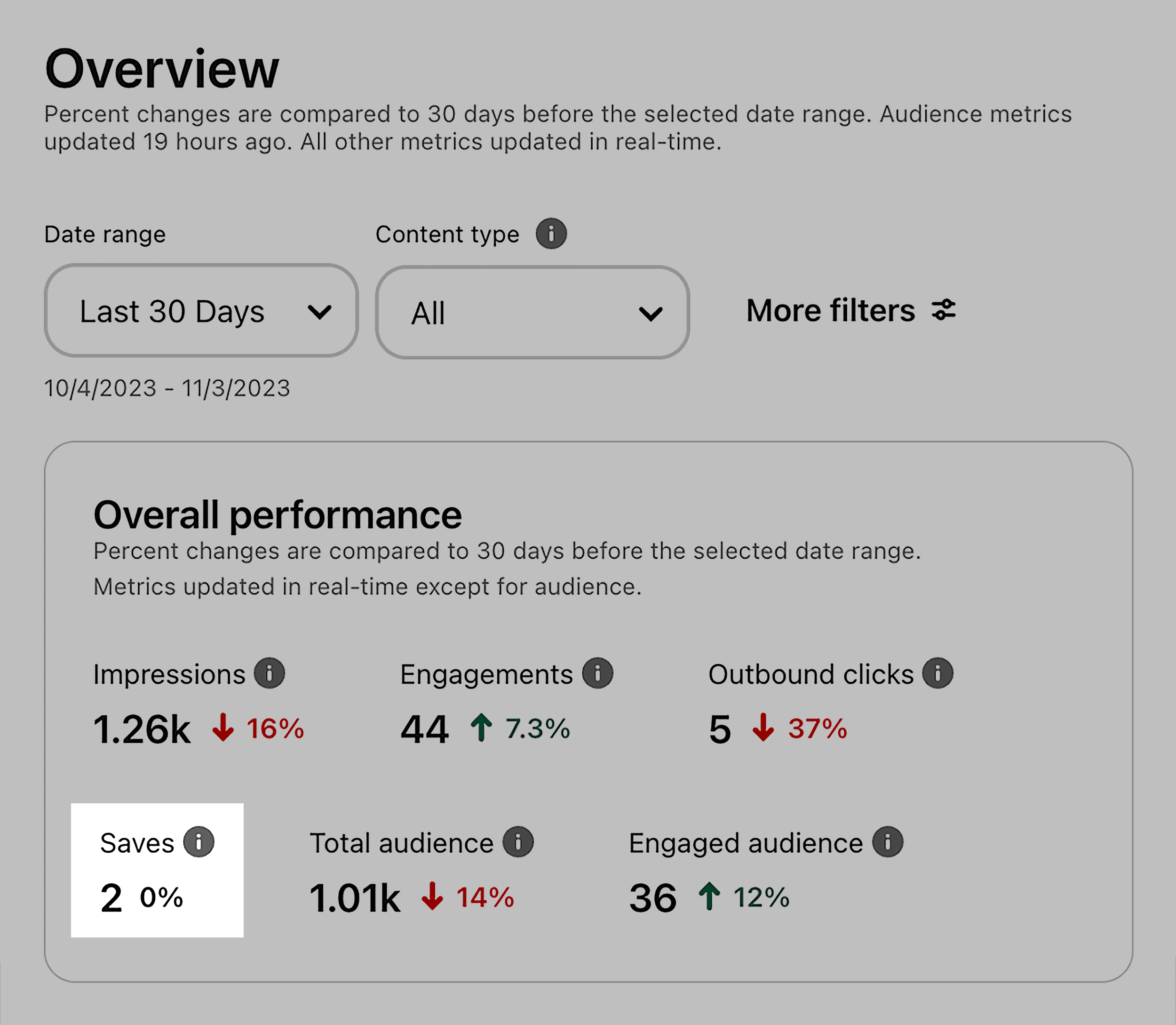
And Facebook tells you how many times users interacted with your content.
Along with providing details on views and follows/unfollows.
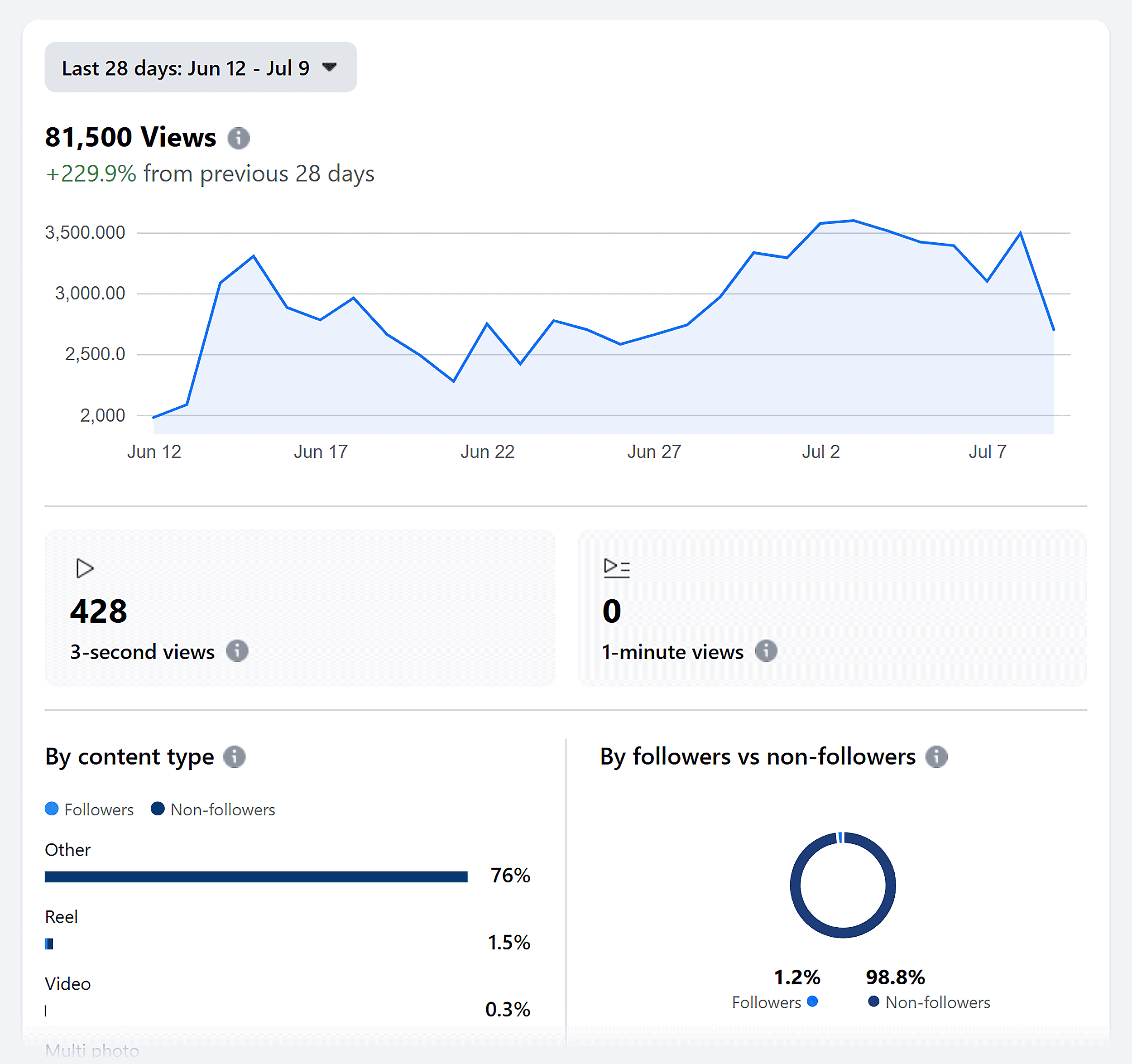
Don’t forget to monitor brand mentions across social platforms.
Tools like Semrush’s Brand Monitoring, Mention, or even Google Alerts can catch when people are talking about your content without tagging you directly.
These organic mentions often indicate the highest quality engagement.
Build Authority into Your Content Strategy
Creating a content strategy takes work, but the ROI is worth it.
When you align content with customer awareness levels, prioritize high-impact topics, and measure what matters, you stop guessing and start growing.
Your next step?
Build topical authority.
The more comprehensively you cover a topic, the more likely you are to show up everywhere that matters.
Including AI search, traditional search, social media, videos, and much more.
Read our Topic Clusters 101 guide to learn how to create clusters that boost visibility and conversions.
Backlinko is owned by Semrush. We’re still obsessed with bringing you world-class SEO insights, backed by hands-on experience. Unless otherwise noted, this content was written by either an employee or paid contractor of Semrush Inc.




